Best Sailboats for One Person (With 9 Examples)
One of the most common challenges of sailing is finding the right boat to sail alone. Luckily, there are some good sailboats out there suited for one person. Let's take a look at them, and find out why they're especially good for single-handing.
In this article, I talk about single-handed sailing and look at the nine best sailboats for one person, ranging from small lake dinghies all the way to comfy cruisers capable of oceanic crossings.
Here are the best sailboats for solo sailing

Jeanneau Sunfast 3200
Beneteau oceanis 62, pacific seacraft flicka 20, tartan 3700, hunter channel 31, j boats 109.
Now let's look at them in detail so that you can choose the one best for you.
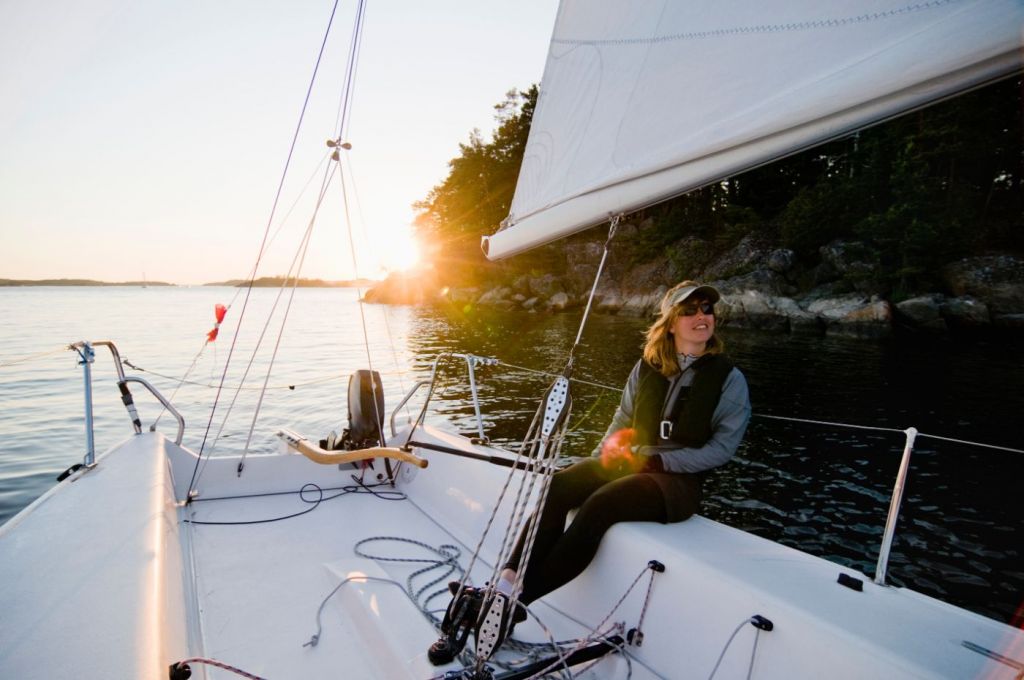
On this page:
What you need for short-handed sailing, features of a good single-handed boat.
Before talking about anything else, let's take a quick look at the features you want in a sailboat for short-handing (a fancy way of saying sailing alone ).
Scroll down to the list of sailboats here .

What to look for in a single-handed sailboat:
- Easy-to-operate sails
- Self-tacking jib
- Self-reefing sails
- Good autopilot
It's nice to have a team of friends, each with their own position within the crew, taking care of their specific thing. One behind the helm, one at the navigation, one trimming the mainsail, one taking care of the foresail, and an extra deckhand just to be sure. But if for whatever reason you want to sail on your own, you'll be the one to fill all those positions.
To make sure that it is physically possible and as easy as can be under the circumstances, start with a good boat choice. The idea is to pick a design that will be easy to operate with just one person available.
Now the good news is that since around 1990, many boat manufacturers have been focusing on ease of operation. That's just what the current market demand dictates. In other words, good single-handed sailboats aren't a rare find.
So what are the specific features to look for when sailing on your own? Let's clear a common misconception first - single-handed doesn't mean the boat has to be small.
Sure, small boats are easier to dock, and things tend to be within reach… but you will find large numbers of 70-footers that are designed as single-handed projects.
You can operate 100-footers on your own. Read all about it in our article What's the largest boat one person can operate?
Easily Operated Sails
A good start are sails that can be operated without much hassle. That doesn't necessarily mean being able to reach all the lines and winches from the helm. If you can, that's great, but if the boat has an autopilot, all you need is to be able to tweak the sails from the front of the cockpit.
Try to avoid setups where you'd have to walk to the mast to play with your sheets - not only it takes time but doing that in heavy winds, tall waves, on a boat that is healing, is a recipe for disaster that nobody is there to save you from.
When solo sailing, the ability to reef and tack quickly is important since those are oftentimes time-sensitive maneuvers. So self-tacking jibs would make your life way easier.
Individually Suitable Boat
The best test, though, is to take the boat out and try it out for yourself. A boat that handles easily in the hands of one person can be unmanageable in the hands of another.
A spinnaker pole might be a handful for the shorter folks, while a 6'2'' 200lbs bloke won't have issues with it.
But don't go around shopping with a 'must-have' checklist. Sometimes the boat is almost there, and all it needs is a little DIY technical push, like adding an extra jammer to the cockpit and running a reef line through it, or getting your hands on a windvane self-steering kit.
As somewhat touched upon before, manufacturers are trying to cater to the ease of use and since technology is going forward, what used to be a hi-tech racing equipment piece years ago, has now made its way into the affordable mainstream.
The canting keel is such an example, something you used to see on racing sailboats only, but now can be put on your average cruiser.
Autopilot Matters
An important part of solo sailing is a good autopilot, for obvious reasons. Luckily, nowadays, these are very reliable compared to what the standard used to be years ago in the cruiser world.
That being said, if you can get your hands on a boat with a proper below-the-deck autopilot with a gyrocompass, you will be much happier than with your average on-deck system, which does the job well, but when things get windier, it might become less reliable.
By the way, racing boats tend to be good solo sailing vessels—they are set up for efficiency. They feature more robust rigging and hulls that can withstand rough conditions and gusts better, and thus are more forgiving, without the necessity to tweak to detail.
I'm not saying that to necessarily have you look for racing boats for your short-handed trips, but rather so that you don't steer away from them on purpose, thinking they would be too much of a handful.
On deck, navigation is a big one too. Again, nothing to cry about if your boat of choice doesn't have one, as it can be easily solved with aftermarket solutions. Or an iPad with the proper app. But having to run below the deck to see where you are isn't the handiest of scenarios, especially in tricky situations.
If possible, consider investing in side thrusters. They can make maneuvering your boat infinitely easier, docking can turn from an unpleasant procedure to a relatively simple joystick play, and especially if you are on a bigger boat, you will appreciate this feature.
We haven't touched on the topic of interiors since it isn't as sensitive as a matter. But having plenty of handles to grab onto regardless of where you are is a good idea, since hitting your head and passing out is unpleasant with a crew, but potentially fatal without it.
To continue with the topic of safety, equipment and boat design aside, remember that you can't really afford mistakes you could make with friends on board. So make sure you have enough spots to clip your harness to, that the boat is sufficiently equipped with communication devices and that all the equipment works as it should.
So let's get specific. What are the nine boats that make great companions for solo sailors?
Let's start with the obvious one—a dinghy. It won't probably be your choice when crossing an ocean, but for practice or a fun day close to the shore, this is one hell of a boat. In comparison to its rivals in the same category, RS Aero is super light weighing 66 lbs. It is among the most technologically advanced sailing dinghies designed specifically for one person.
All of this comes for a price though - 10 000 to over 15 000 USD. You will be getting your money's worth for sure though. An enormous amount of hi-tech work went into this project, and you'd be buying a design that won more awards than could fit on its 13-foot body.
This is a big step up from a dinghy, while still keeping things very simple. It is a lightweight boat, originally designed for a transatlantic race. Thanks to that and its small size, it is easy to handle, the racing pedigree shows in the efficient layout, so everything is within reach. Despite its smaller size, it can reach speeds you would expect of much larger boats.
You can find small family cruisers of the same size, but don't let that fool you. This is very much a Spartan sailboat. Inside, you won't find much more than the bare necessities - two aft cabins, curtains instead of doors, simple seating, not much lining or wood, just a notch above barebones interiors. You get a toilet though, a chart table and a galley as well as much stowage. But you will be reminded of being on a racer, because unless you are shorter than 5'7'', you won't be able to stand up straight.
As mentioned, this boat was designed for a cross-ocean race, so it is a seaworthy bluewater mate that should be able to take you more or less wherever you want to.
Time to go big. As previously mentioned, solo sailing doesn't mean you have to stick to smaller sizes. Why? Because it is a trend now. Even though just some ten years ago, the situation was vastly different, these days, single-handed 60+ footers aren't anything rare.
So why this Beneteau? Well, for one, to meet the new kinds of market demand, it was designed for ease of use, meaning it can be successfully operated by a single person. I don't know what you'd do alone with all that space, but if you want to enjoy oceanic solitude while not giving up the luxuries of having space the size of a family apartment, you can.
And while there are more boats of this size suited for short-handed sailing, like the larger Jeanneaus, Hanses, or even Bavarias, the Oceanis 62 can be yours for around 600 000 EUR new, which is a figure unheard of in that size and quality range up until relatively recently.
This is not the first time I am mentioning this boat in an article, and no wonder, it has so much character! Like others in this list, this one has been designed for single-handed sailing - it had to be. You couldn't fit two people on it comfortably anyway.
So aside from its solo capabilities, why does it deserve to be on the list? Well, it's towable, which you could say about the RS Aero too, but you can actually live on a Flicka, and it is seaworthy. It is about as small as you can go while still being able to cross oceans.
There is no question about everything being within the hand's reach on this one. Ergonomics almost don't matter at this size. Given its towability, the fact that you can park it in your garden, and its short-handed potential makes for the perfect spontaneous getaway mobile.
Another boat you can live on. It is a seaworthy ocean crosser, and thanks to its setup and a self-tacking jib, it is a proper short-handed boat. It also has quite a wide beam, thanks to which you'll get additional stability, further supporting comfort when operating it solo. It is made by a brand that proved its worth over time, as since the 70s, it is still going strong. It's comfortable enough for long distances, with a spacious salon, shower, and space for a small family.
Used, you can get one starting around 150 000 USD, which is one of the reasons why it belongs on this list - if you are serious about solo sailing and want a proper boat without compromises that come with smaller sizes or sportiness, this one is within a reasonable reach. Among the affordable, high-quality, short-handed sailing cruisers, Tartan 3700 has its definite place.
This is the kind of boat I was talking about when I mentioned that formerly racing design aspects started to make it into the cruising world. Hunter started as a racer builder and then shifted to cruisers, while, of course, taking its know-how with them, which makes for boats that are easy to operate, also well-performing ones.
This specific model got on the list because of its low center of gravity, high ballast ratio, and stable hull, which means you won't have to trim the sails all the time to go fast. And less work is always welcome if you are the only person to do all of it.
Another reason it's gotta be here is it is very efficient layout, self-tacking jib, and single-line mainsail reefing system—a smart choice for solo sailors.
If you like what you saw in Hunter Channel 31, but fancy something a bit faster, with a higher quality build, this one's what you want. It has lost much of its sportiness as it is too heavy to be thought of as a proper performance boat today, but in the worst-case scenario, it is a quick cruiser capable of satisfying sprints.
It was designed for single-handed sailing as well as for full crewed racing, so if you want to push as much as you can out of it with a team of your mates, you can, while knowing you will be able to cruise at a good pace when they leave.
So unless you mind the slightly higher price tag, which comes with the high build and components quality, as well as the less generous interior fanciness usually seen in racers, you've found yourself a boat.
The best thing about solo sailing is also the most dangerous thing about it - you will be alone. So you want your boat to be your buddy - forgiving as much as can be, having your back. Amel 60 is such a boat. It has watertight bulkheads, so it is hardly sinkable, its cockpit has a solid roof and windows, so no matter the weather, you'll be protected while behind the helm, it has a stable hull, offering support even in tricky weather, it features electric winches, so you can operate the sails without even touching a line…
...and inside, you get more space and luxury than you could wish for, including a washing machine. All in all, if there is a boat that's got your back even if your skill level isn't the greatest, it is Amel 60. All it wants from you is to be ok with the 1.5 million USD price tag.
Have you seen the film "All Is Lost"? An incredible project without dialogue, where a solo sailor on a Cal 39 makes his way through an ocean. Now, what makes Cal 39 such a great boat for solo sailing? As it turns out, nothing in particular. It wasn't designed with this in mind. It isn't even a notably successful model - though that's mostly due to technical circumstances rather than a lack of quality.
And that's why it must be on this list. To represent all the boats that aren't single-handed projects by design, but make it possible, if you get to know the boat, spend some time with it, and, as mentioned at the very beginning of this article, tweak it so that it makes solo sailing easier.
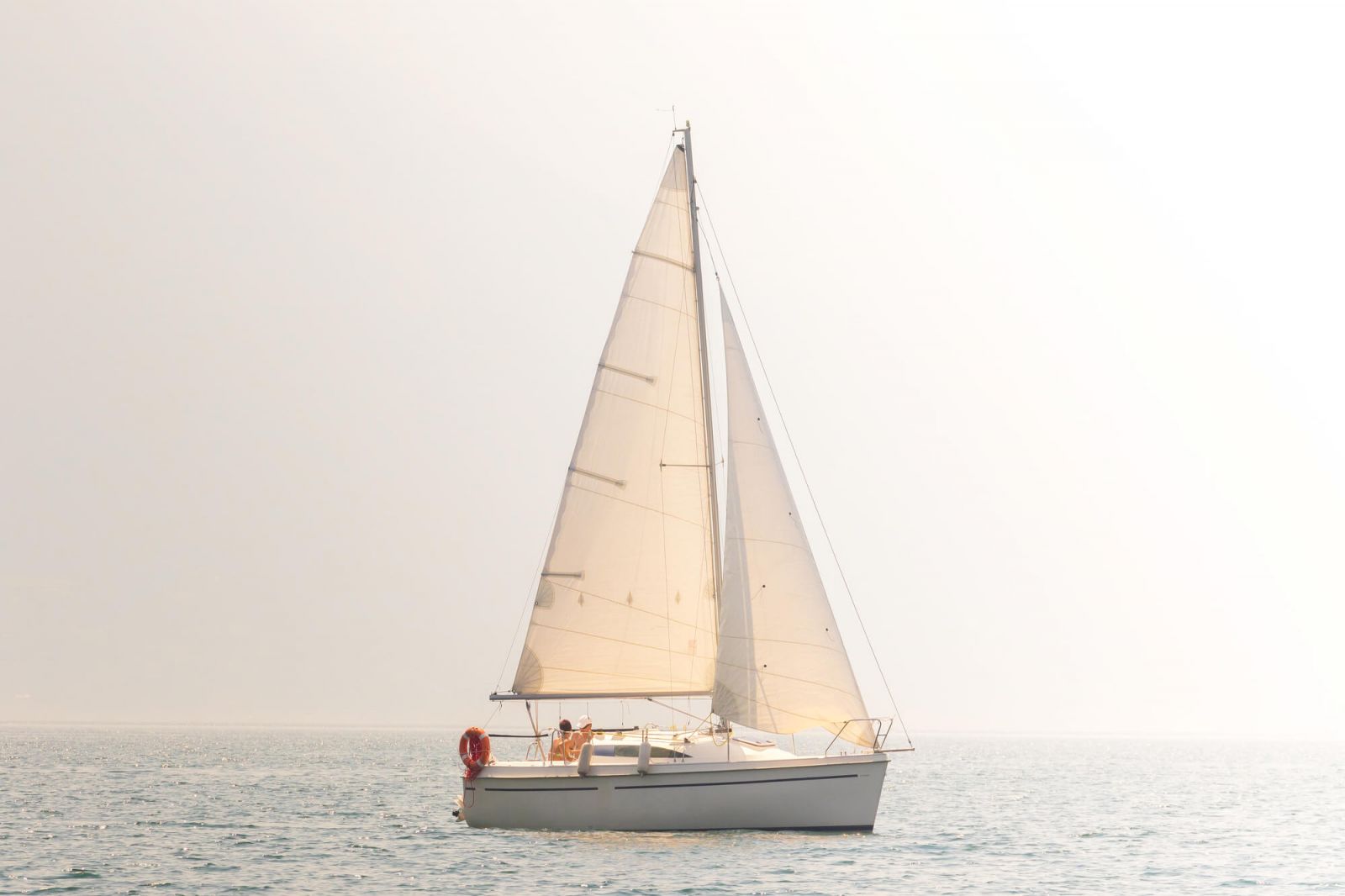
By this, I want to encourage you to get into solo sailing, even if you lack a sailboat that is specifically made for a one-person crew. Quite a few single-handed passages have been done on boats that wouldn't make it to this list because technically, they don't fit the profile. But they were made to be, either with tweaks or with skills. Be honest to yourself regarding your skill level, the boat design, and if it passes the test, go for it.
Happy sailing!
Leave a comment
You may also like, what’s the largest boat one person can operate.
So you're looking for something big, but want to go at it alone. Sailing single-handed (also known as short-handed) is perfectly doable, although not always ideal. …

Raising the Mainsail Single Handed: 5 Pro Tips

How Big Should a Sailboat Be to Sail Around the World?
Own your first boat within a year on any budget.
A sailboat doesn't have to be expensive if you know what you're doing. If you want to learn how to make your sailing dream reality within a year, leave your email and I'll send you free updates . I don't like spam - I will only send helpful content.
Ready to Own Your First Boat?
Just tell us the best email address to send your tips to:

11 Best Single Handed Bluewater Sailboats

Sharing is caring!
We know that you’re serious about sailing when you finally think of venturing to the ocean. Who can resist dreaming of solo sailing through the Atlantic? This is an adventure to prove your advanced skills, strength, and experience.
But before going off on your ocean adventure, you need to plan and prepare . We cannot stress enough the importance of good equipment. There is a lot of sailboat types and models in the market and we want to help you choose the best one for your needs.
Do you know what hull, rigging, and keel types you will need? What’s the best material and model for you to buy?
We will guide you through important sailboat features needed for the cruise. Follow this review until the end and we will share the 11 best single-handed blue water sailboats for your solo ocean sailing!
What Size Sailboat Is Best for Single-Handed Sailing
What type of hull handles rough water the best, sailboat keel types for blue water sailing, keel or decked stepped mast, sloop or ketch, how many spreaders, cutter rig, self steering gear, furling sails, westsail 32, albin vega 27, pacific seacraft 34, canadian sailcraft 36 traditional, hallberg rassy 352, contessa 32, fast passage 39.
If you are planning to manage your boat single-handedly, then size is an important factor to consider. It can affect the size of your accommodation, and maybe the boat’s design for speed and power.
Being alone, you need to have a clear overview of what is happening on your boat. This is especially important when maneuvering or for docking operations.
Experienced sailors can handle a 60-foot sailboat but novices would find it difficult with its steep learning curve . Check out the Vendee Globe if you don’t believe me. In general, a good sailboat size for single-handed sailing would range from 25 to 40 feet.
We recommend sailboats with sizes under 40 feet. These have good displacement and are great when against bad weather. They are solo-friendly and simply the most manageable.
But in the end, choosing a suitable size depends on your experience and preference. You need to consider your overall health, age, and physique. Make sure to have a complete understanding of your sailboat before going on your journey to prevent accidents.
The hull or the main body of your boat comes in varying shapes and sizes. Each different type of hull is designed for specific purposes.
When venturing the blue waters, you need to have a hull design that could handle rough waters easily. The hull shape determines the performance of your sailboat and therefore, should align with your strengths and skills.
Today, the most popular design would be the heavy displacement hull . This design is intended for ocean cruising and longer sailing travels.
It has great stability and performs better the deeper the draft is. With this design, you would expect a slow and steady motion during your sea travels with minimal effort.
V-type hulls, on the other hand, are designed to plane or ride on top of the water. You can usually see these types of hulls on powerboats. The V-type hull usually has a bigger engine and best when dealing with choppy waters while moving at high speed.
Narrow beams are also a great option for those who are looking for another ocean friendly feature . These are usually seen in traditional sailboats.
Canoe stern or the double are considered to be the best sterns for offshore sailing. They help cut through a following sea and really helps prevent the waves from pushing the stern over too much. It also has great buoyancy and balance that is perfect for bluewater cruising.
The best materials for hulls would be fiberglass, metal, and aluminum. These are durable and could last for decades if properly maintained.
Aluminum is lightweight and has resistance to corrosion and impervious to magnetism. Boats built with aluminum are fast, stable, and seaworthy.
Fiberglass hulls need less attention. Currently, boats are usually made of fiberglass as the material is easier for companies and also great for seakeeping and stability.
Metal like steel has high abrasion resistance. It helps retain the boat’s appearance but can be prone to rust and corrosion.

A keel is a fin-like blade found at the bottom of a sailboat. It supports the ballast and helps to control and steer the boat.
It is generally designed to stop the boat from getting blown sideways because of wind pressure. The full keel, modified full keel, fin skeg, and fin spade rudder are all suited for bluewater sailing.
A full keel runs along the full length of the boat – from the bow to the stern – which makes it the most stable in the water. It carries the vessel well and is the safest to use when grounding as it reduces the chances of damage.
This is most ideal when cruising and the most comfortable out of the four keel types with its minimal heel. Although the slowest on the list, it has great directional stability and steering capability.
An improved version is the modified full keel . It is a hybrid with improved windward performance and better heel reduction than the full keel. However, it made small concessions on its stability and comfort.
Meanwhile, the fin keel with skeg rudder has more strength and protection against damage and impact. It also has better mobility and steering capability.
This type has a faster speed and windward performance compared to the modified and full keel types. It is also more balanced, which is ideal for cruiser-racer types of sailboats.
Lastly, we have the fin with a spade rudder. This is the fastest type on the list but also the most vulnerable as the spade rudder greatly relies on the rudder stock. But if you want speed and great windward performance, then this type is the right one for you.
Sailboat Rigging Types
Rigging is the whole system of ropes, chains, and cables. It supports the sailboat mast and controls the sails’ orientation and degree of reefing.
There are two main groups of sailboat rigs, Deck Stepped and Keel Stepped. The main difference lies in the location of its mast step. Both are fine choices and the better rig would depend on your preference.
Just as its names suggests, you can find the mast stand on top of the deck with Deck Stepped and on the hull’s bottom with Keel stepped. This means that to reach the keel, the mast would need to pierce through the cabin.
Deck Stepped rigs have masts that are more flexible because of their contact points, and are easily adjustable for optimal performance. Keel Stepped rig is rigid and strong and offers slow and steady cruising.
Now let’s move on and talk about Slope rigged and Ketch rigged. Which is better?
A sloop rig is simple. It is composed of a mast with a jib and a mainsail. Ketch, on the other hand, is more complex with its two masts with any foresail, main and mizzen mast combinations.
If you are choosing between Sloop and Ketch rigged sailboats for solo sailing, then we recommend Sloop. Although, Ketch is manageable and can be easily used with less strength and effort. This is perfect for cruising as it can work around multiple sailing conditions.

In terms of spreaders, you can freely choose between a single or dual spreader. This deflects shrouds and supports the mast. We do recommend dual spreaders but single spreaders are also good.
It’s just that double spreaders give the rig more strength and better sail control.
The cutter rig is sometime referred to as an inner forestay or baby stay. Simplest way of describing it is that you have two head sails instead of just one. Gives you more options on sail configurations.
Single Person Sailboat Equipment and Gear
Your sailboat would not be complete without gear and equipment. You might want to invest in autopilot or wind vane, furling headsails, electric windlass, life jackets, and AIS to make your voyage much easier.
Wind Vane is an autopilot steering that you can use without electricity. It is usually placed on the back to catch the wind and respond to various wind conditions.
It automatically adjusts the rudders in response to the wind to alter the boat’s course. This is helpful because it’s like having another crew member on board you don’t have to listen to and feed.
Headsail furling or roller reefing is necessary for easier management of your headsails. It is important to have a functioning and updated roller furling system in order to reef, dowse, or stow the headsail efficiently.
Another item we would recommend is an electric windlass . You can choose one that works vertically or horizontally, depending on your needs. This will help you move the anchor effortlessly with a single button. Using the two windlasses that god gave you makes anchoring more difficult then it needs to be.
Life jackets are a must in every sailboat. Just be sure it fits you and that you know how to use it. Also, be sure to buy a coast guard approved product with a harness that could support your weight.
The Automatic Identification System (AIS) will help you avoid collisions . It is recommended to get a receiving and transmitting one when going solo sailing.
This way, you and the other boats with AIS within the radar area are alerted to each other’s speed, course, and direction.
Really, you won’t know what you might encounter in the ocean so you must always be prepared. We hope that these items will help you achieve a safer and more secure sailing experience.
11 Best Sailboats for Solo Sailing
Now, here are 11 sailboats that are best for solo sailing. Any of these vessels are guaranteed to take you safely and comfortably anywhere around the world.

This is a long full keel fiberglass sailboat that was built from 1971 to 1981. Its design was based on a previous model, Kendall 32, and has an amazing interior size geared for comfortable cruising.
W32 is widely noted for its seaworthiness. It is built with a strong and durable design and materials to resist extreme sea conditions.
It was used on various voyages and circumnavigations. Its hull is a heavy displacement and double-ender type designed for long periods of sailing.
It is also a cutter-rigged sailboat equipped with a single mast, forestaysail, mainsail, and jib. Its overall length including the bowsprit and boomkin is roughly 40 feet, which is perfect for sailing single-handedly.
Most people would note that the speed and acceleration of W32 are quite slow. This is due to its larger wetted area and sometimes newbies’ mistake of carrying too much on board.
With the right keel, sails, and rig configurations you can improve on W32’s speed and weaknesses. As seen from David King’s documented modifications, W32 proved to be safe, steady, and fast when sailing on blue waters.

Vega 27 is a modified full keel sailboat with a masthead sloop rig. It was designed around 1966 and became the most popular production sailboat in Scandinavia.
It has a unique look because of its reverse sheer commonly seen in smaller boats to increase the area of its interior. It is made with fiberglass, but has a narrower hull compared to similar sized boats in its class.
Its shallow hull has a large cutaway as seen with modified full keel designs. This can make her quite stiff, heeling to about 15 degrees when its shoulders are buried.
Still, it is great for single-handed sailing because of its manageability and balance under different conditions. You cannot help but admire its light helm and great tracking capability.
Vega’s light air performance is okay but it shines when the wind blows at 15 knots or more. It could even maintain its dryness even with rough waves and weather conditions.
The most comforting feature would be its control and stability at all times unlike other more modern vessels with spade rudders. Overall, it is safe and ideal for longer cruises offshore.

This 30-foot traditional sailboat could take you anywhere. Alberg is notable for its narrow beams, long overhangs, and full cutaway keel with its directly attached rudder.
It is strong and durable. Its materials were mostly aluminum, hand-laid fiberglass, and polyester resin. More ballasts were produced in later productions as the early ballast was built with iron as opposed to the original lead design.
Alberg is greatly influenced by folk boats in Scandinavia. It is built with fiberglass and has an interior with comfortable full standing headroom and a well-vented galley.
This classic design from 1962 is ideal to cross oceans and is used for various circumnavigations. Alberg is a stable and seaworthy boat that could even be used in casual racing. Its best point of sail seems to be a beam reach and close reach.
It is praiseworthy when crossing oceans. Unlike modern designs that tend to be thrown around on rough seas, Alberg’s narrow beam design slices through big and rough waves and moves quickly. Under extreme weather conditions, it could perform heaving-to and lying-a-hull with no problems.
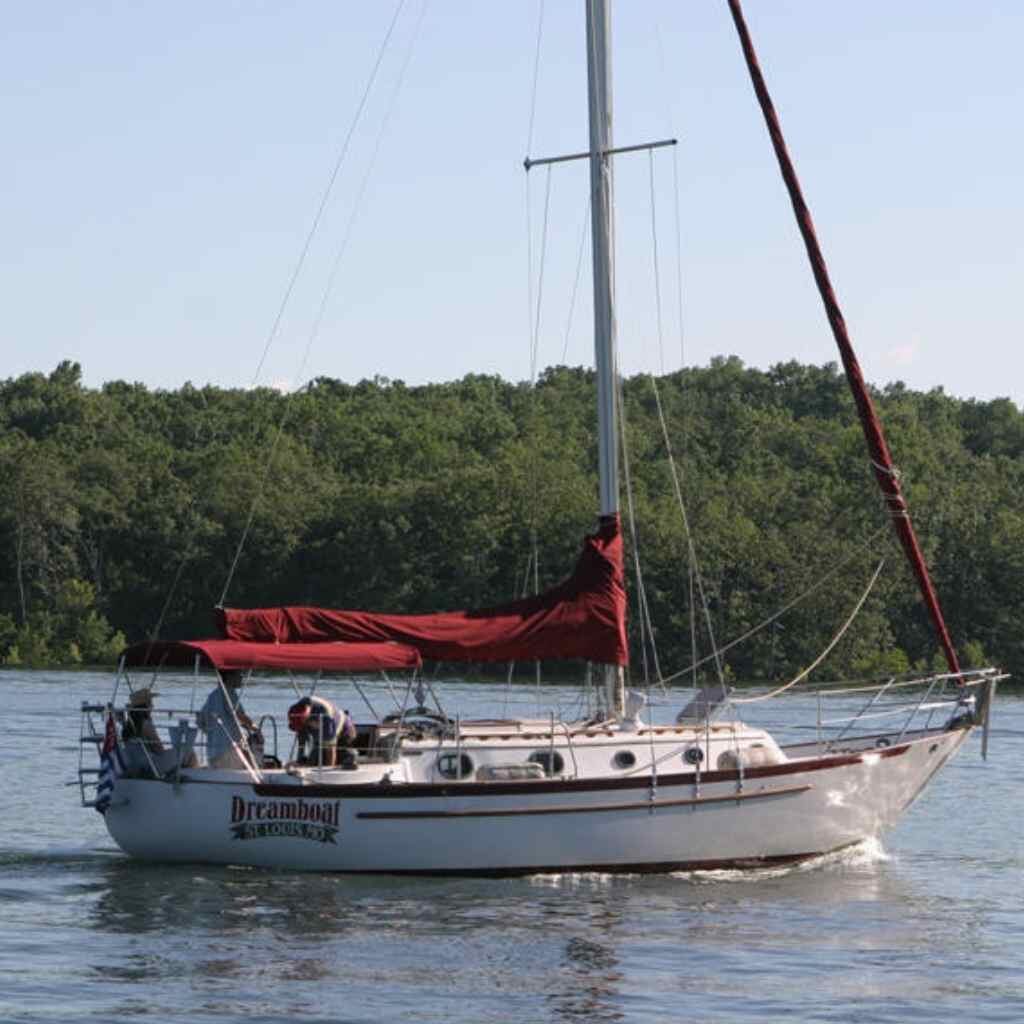
Pacific Seacraft 34 is a smaller heavy displacement semi-long keel sailboat based on the highly successful Crealock 37. It has the same graceful lines and appearance as the Crealock and is known as the Voyagemaker.
It is built with comfort and safety in mind with its large overhanging bow and beautiful sheer line ending with a traditional canoe stern. Constructed with the highest standard, it is a seaworthy sailboat that is ideal for bluewater voyages.
It is a cutter-rigged sailboat with skeg-hung rudders and control lines being fed back to its cockpit. The smaller cockpit may feel cramped but its design lowers the risk of flooding.
Still, it has a great interior suited for living aboard. It has a large headroom, comfortable galley, and up to five berths for comfortable cruising.
Although you may feel some hobby-horsing windward because of the overhangs, Seacraft 34 is overall a very balanced boat with great upwind performance. It has outstanding control capabilities and is able to sustain surfing speed with ease.

This is a double-ended full keel cruiser designed by Bob Perry and built-in Taiwan in response to the rising popularity of Westsail 32. It was offered to the market as a semi-custom boat and built with high-quality materials.
You can modify the internal layout and can choose a ketch, cutter, or pilothouse version. There is an option to use wood or aluminum spars. The mast could also be keel-stepped or deck-stepped.
Before, only 20 were ketch sailboats due to the popularity of the cutter design at that time. Now, ketch has proven to be faster and more balanced between the two.
Tayana is relatively faster than any sailboat in its class. Its best point of sail is in its broad reach. It also tracks well windward, and is an ideal choice for the trades. It is also great how the cockpit is secured from any flooding even when traveling.
Today, a lot of people are still actively sailing this. Tayana 37 has become well known for offshore and blue water sailing.

Canadian Seacraft is well known for its fiberglass racer and cruiser. CS 36 is a small traditional fin keel sailboat with a masthead sloop intended for recreational use. It is seaworthy and has good performance in different weather conditions.
It was designed by Raymond Wall and had a production run between 1978 to 1987. It remains to be popular in both north and south borders.
It is a beautiful sailboat with a graceful sheer line and balanced overhangs at both bow and stern. Its details and quality in design and production are clearly of a higher tier.
It is mostly built with fiberglass and balsa wood. It is equipped with an internally mounted spade transom hung rudder. All of its lines lead to the cockpit, which is ideal for single-handed sailing.
CS 36 Traditional also has a deep-depth draft and wide beams with great access to the cockpit and foredecks. It is wide and spacious, which is perfect for comfortable cruising.
The sailboat has great proportion and traditional aesthetics. It is simple and straightforward, which makes it ideal for bluewater sailing.

This is a sturdy and high-quality sailboat built between 1978 to 1991. It features a progressive design, combining a walk through with the aft-cabin from the main saloon. It is made with a tall and standard rig each supported on double and single spreaders, respectively.
Hallberg Rassy 352 has a nicely balanced hull sporting a fin keel with rudder on skeg, a generous beam, and a 45 percent high ballast ratio. Its water and fuel tanks are placed low in the keel to improve sail carrying ability.
Its production spanning 14 years allowed for continuous improvements in its specifications. Newer sailboats have raised hulls for bigger headroom in the under the deck, aft cabins, and the walkthrough. Engines were also replaced by a Volvo and later a Penta Turbo or the bigger MD 22.
It is impressive how they balanced good interior and sailing performance. It has great seakeeping ability and smooth motion in heavy seas, easily an ideal sailboat for singlehanded sailing.

Corbin 39 was designed based on a Dufour design named Harmonie, increasing freeboard, and flushing the deck. Its style is influenced by the classic Scandinavian cruiser, Westsail 32.
It has a long fin keel, blunt bow, and a high freeboard. It was sold as kits, and various deck molds were produced. They have pilot, aft, and center cockpit variations.
It was made of sturdy and high-quality materials. The earlier version’s decks were of marine grade mahogany but it was later changed with Airex foam. Its lead ballast was encapsulated with fiberglass for added protection.
Earlier boats had a single spreader main or a turbocharged double spreader. Later, Corbin used 49 feet double spreader rigs instead, and all were deck-stepped.
Corbin 39 is truly a strong and seaworthy vessel. With its fin keel and skeg rudder, cutter rig, and reefed main combinations, it could take anyone safely and comfortably anywhere in the world.

Valiant 40 took its looks from Scandinavian double-ender sailboats. It had a successful production run that spanned for 47 years. It proved to be one of the pioneers for modern blue water designs.
Its hull is made from thick hand-laid fiberglass, bolted and covered with teak. Its ballast is cast with lead bolted to the keel stub. Lastly, the skeg is constructed separately from hull molding and encased with fiberglass before being fastened to the hull.
It has a beautiful bow and sheer lines and a longer LWL for maximum speed. At the back are a non-spacious cockpit and a canoe stern ideal for bluewater sailing operations.
Under the waterline is a fin keel with its skeg hung rudder. It perfectly matches with the cruising hall above, minimizing wetted surface area
Overall, Valiant 40 is a seaworthy vessel with great blue water performance. Extremely balanced and well-mannered, it can withstand extreme weather conditions with ease and minimal effort on your part.
It soon gained a reputation as a fast water passage-maker with high integrity. Now, it is regularly used for circumnavigations by solo sailors and voyagers.

If you like a sailboat with a proven track record, then Contessa 32 is for you. It is a seaworthy racer-cruiser with good all-around sailing capabilities released in 1971.
Like its younger sister, Contessa 26, it has great speed, integrity, and affordability . Contessa 32 is a definite combination of old and new with its traditional narrow beam, a full hull with a fin keel, and fiberglass rudder protected by a skeg found in more modern yachts.
It has marked overhangs and a narrow tuck-up stern. It has less headroom below in return for its lesser wind resistance.
This configuration delivers fast racing speed and great stability. It could definitely withstand extreme weather and rough waves. Contessa 32 is claimed to be able to right itself when rolled or capsized.
Contessa 32 is known for its forgiving nature. It has a responsive helm and excellent windward performance. With its astounding stability, it can carry full sail for up to 25 knots.

Fast Passage 39 was designed by William Garden and is said to be a legendary cruiser with speed, ruggedness, and fame. It is a stout double-ender comparable to the Valiant 40.
It has the same LOA and LWL as Valiant and also has nearly identical ballast and displacement. The difference is its narrower frame and more evolved underwater shapes resulting in flatter forward and aft keel sections and less wetted area. It also has great directional stability as its rudder allows great control under wind vane and down steep waves.
It is a high performing sailboat but also difficult to find as only 41 were produced. A part of the group was offered as hull and deck kits intended to be finished by the sailboat owners.
Fast Passage 39 also has a proven track record and has won single-handed blue water races. It performs great under a wide range of conditions, especially in light winds.
By now you should have some idea what makes a vessel Bluewater friendly. There are hundreds of vessels that can make long distance voyage safe and enjoyable. These examples above are just a few examples of the Best Single Handed BlueWater Sailboats.
Leave a Comment Cancel Reply
Your email address will not be published. Required fields are marked *
Save my name, email, and website in this browser for the next time I comment.
Get your "Sailing and Boating" Free Guide

What Sailboats Can Be Sailed By One Person? (Complete List)
We all love sailing together with friends and family, but sometimes we can’t get them to come out with us. When that happens we must sail solo. Sailing solo can be hard sometimes but if it’s just a day sail in nice weather you shouldn’t have a problem.
There are a lot of options when it comes to picking a boat for one person. More than likely, you can sail the boat you have by yourself, but if you are considering buying one and want to be able to sail it yourself, then this article will help you find one.
1. Catalina 22

I believe this is one of the best boats for first-time sailors sailing solo. Yes, this is what I started on and a lot of people do. I have had dozens of people come up to me when I was with my boat and they would tell me all about their first boat which was a Catalina 22.
They are great starter boats and very easy to handle. They may not be big enough for crossing the Atlantic, but any bay or lake sailing and they will do just fine.
The Catalina 22 comes with a swing keel, which allows you to enter those shallower waters. This makes it very convenient for lake sailing and running it up onshore. It has a draft of 5ft with the keel down and a displacement of 2,250 lbs. Another unique feature of this boat is the pop-top. Being able to pop the cabin top up a few feet increases the headroom down below. It’s a great little feature that just adds to the fun of this boat.
If you’re looking for your first boat and want to sail solo, then this is the best option in my opinion.
2. 30′ Hunter Cherubini

The 30-foot hunter is a very common sight around the docks. It is a very solid boat and easy to handle. The hull is extremely solid when well kept and great for the open ocean. I have sailed on one of these in the Gulf of Mexico and it did very well.
The last year of production was 1983, but there are still plenty of them out there. That’s because they are very well built. It has a max draft of 5.25 ft and a displacement of 9,700 lbs. It’s a heavy boat which makes it good for open oceans.
I have seen these for sale under 10K making it a great option for purchase. Depending on if you have the money of course.
3. Catalina 250

This is one of my favorite Catalina models. I love how the cockpit has extra room and the cabin still has plenty of room. It is only 25 ft long making it a great size for solo sails. If you are looking for a good weekend boat, I definitely recommend this one.
Its LOA (length overall) is 25 ft even. The draft is 5 ft with a wing keel. (click here for information on keel types) Displacement for this vessel is only 4,200 lbs. This boat will require an outboard motor for getting in and out of the docks. If you need one click here.
4. Hobie 16

The Hobie 16 has to be mentioned in this list. It is a super common boat and it is seen all over the world. There are some people that race these professionally and others that use them recreationally. They are great for kids and adults alike. If you are ever at a resort you will usually see these on the beach for rent.
The Hobie 16 has a weight of only 320 lbs making it easy to flip over when needed. With the rudder in the up position, the draft is only 10 inches. It fits up to four people, but you might be able to fit a couple more.
This boat is all about fun! Don’t sail it across the Atlantic though.
5. Catalina 36 MK II
This boat is over the average of 30 feet but that doesn’t mean you can’t solo sail it. Like I said earlier it all depends on experience. The Catalina 36 MK II is another one of my favorites. I love the size and look of it.
If you want something just a bit bigger than the 30-footers, then I recommend this one.
The draft is 5.83 ft and the displacement is 13,500 lbs. It has two cabins giving you a guest room for overnight guests. This is definitely one of my favorite boats out there. It is just a perfect size, not too big and not too small.
Just remember it is 36 ft which can get more difficult. Once you practice with it enough, you should be able to sail solo when you want. If you plan to cross the Pacific in it, it is a good size for that, but having a couple of extra hands for the journey wouldn’t hurt.
6. Macgregor 25

The Macgregor 25 is an interesting boat. The first version was called the VENTURE 25. After a few changes to the design, it became the MACGREGOR 25. With more than 7000 boats sold, it’s one of the most popular models from this builder.
I looked at one of these for purchase once but did not go through with it. I ended up with a Catalina 22. That doesn’t mean this boat isn’t right for you though. It is a tiller steering setup if that is something you are considering. I started with a tiller and I think all people should.
The draft of this vessel is 5.67 ft. The displacement is 2,100 lbs. It is not the biggest boat out there but it is still a good choice if you are just starting out and want to do some solo sails.
7. Beneteau First 27
If you have the money, this is the one for you! This new model from Beneteau is most impressive. The speed of this boat will feel like you are in the middle of a race, or more like leading the race. It is designed for speed and comfort, with sleeping up to six adults. It is also designed where a single person can sail it as well.
This boat has a displacement of 3,747 lbs and the draft is 5 feet and 7 inches. The keel is a T-bulb design, making it very unique. We all know the Beneteau brand for being luxury on the water and this one delivers in a minimalist way. Check out the video below to get a real feel of this amazing sailboat.
8. Hunter 33 Cherubini
Another Hunter sailboat for the list. This is just a little bigger than the 30-foot Hunter mentioned earlier. It is very similar and still designed by Mr. John Cherubini. The draft is 5.25 ft and has a displacement of 10,600 lbs.
The design was originally marketed by the manufacturer as the Hunter 33 but is often confused with the 2004 Hunter 33-2004, which was also sold as the Hunter 33, and the 2012 Hunter E33, which is in production as the Marlow-Hunter 33.
Hunters are always a very solid choice.
9. Laser Sailboat

The Laser is a class of single-handed, one-design sailing dinghies using a common hull design with three interchangeable rigs of different sail areas, appropriate to a given combination of wind strength and crew weight. Bruce Kirby designed the Laser in 1970 with an emphasis on simplicity and performance.
These are great boats for racing around the lake. They are very popular for racing, but can also be used for recreational sailing. Sunfish are a type of dinghy sailor very similar to lasers but are usually built for recreational only use.
10. O’Day 25

O’Day is another one of my favorites. I love their classic look and feel. This is a very popular model from the O’Day company.
The boat was built by O’Day Corp. in the United States, with 2,898 completed between 1975 and 1984, when production ended. It was one of the company’s most successful designs
The O’Day 25 is a small recreational keelboat, built predominantly of fiberglass, with wood trim. It has a masthead sloop rig, a transom-hung rudder, and a fixed fin keel or centerboard. It displaces 4,007 lbs and has a draft of 4.25 ft.
What Size Sailboat Can One Person Handle? Depends on Experience
The average size boat that most people sail solo is a 30-footer. It is very common to see people sailing by themselves or with others on this size of boat. The size is easy enough to maneuver by yourself and the sails are easy to manage when you are all alone.
This does depend on experience though. If you have never sailed before then a 30-foot boat may be too much to handle. There are a lot of things that can go wrong when sailing and not knowing how to handle them will put you in harm’s way.
There is no specific timeline that will tell you when you are ready to captain a 45-foot sailboat. It comes down to confidence. Are you comfortable sailing a 45-foot vessel by yourself? If you answered yes, then you are probably good to go, unless you are just overconfident.
Sailing certifications will usually certify you to captain a boat up to a certain length. All though you are certified you may not have the confidence still. Being confident is a huge factor. When problems come up, confidence will allow you to stay calm and resolve the issue. Don’t think you can handle anything the sea throws at you just because you have a certification.
Check out this article on sailing certifications to find out more!
Factors To Consider When Sailing Solo – General Guidance
When you are considering a boat for solo sails there are a few thoughts to keep in mind.
First, how big of a boat do you want? The bigger the boat gets the harder it is to handle by yourself. Do you want this to be a sailing solo-only boat or do you want the option to have people with you when you sail? Consider safety on the boat. If you are going to be sailing by yourself you need to make sure you have the best safety gear.
What sails are needed? The self-tacking jib may be something you want to look into. A furling jib is a minimum in my opinion. Supplies are a general category to consider. Supplies will mean spare parts in case something breaks, food and water for the trip, and anything else you might need.
Gear For Sailing Solo – Multiple Items
When it comes to sailing solo, there is some gear you may need. Check out the list below for recommendations on gear for solo sailing.
- Autopilot – When sailing out in the open ocean, the autopilot will be necessary if you ever want to sleep. It is very nice to turn it on while you take a nap or go fix something on the boat.
- Windvane – Windvanes are also great for steering when you are busy. They use wind and cabling to steer the boat. They are a great thing to have in case the autopilot goes out. Plus, if the wind vane breaks for some reason, you might have a better chance of fixing it compared to an autopilot.
- Safety Tether – These are essential for solo sailing in the open ocean. When the water gets rough, make sure you are attached to the boat so you don’t fall off. Never go on deck in rough conditions without a tether.
- Emergency Position Indicating Radio Beacon (EPIRB) – This is also an essential item when sailing around the world. One thing to make sure of is easy access. If you are in trouble you don’t want to be digging under the v-berth looking for this. Put it somewhere close to the cockpit.
- Supplies – This covers all items you may need from spare parts to canned foods. Remember to plan accordingly. Not planning is planning to fail.
These are just some of the essential items needed for multiple-day sails in the open ocean. Always plan and think about what is needed.
In Conclusion
This article discussed the different types of boats that one person can sail. My personal recommendation if you are just starting out is the Catalina 22. It was my first boat and I loved it. If you need something bigger the Catalina 250 is a great weekend boat.
If you are an average sailor look for something in the 30-foot range. That is usually a safe length that won’t get you into trouble.
As always make sure you have the gear that will keep you safe out there!
Boatlifehq owner and author/editor of this article.
Recent Posts
Sailboat Racing - Rules & Regulations Explained
Sailboat racing, a blend of skill, strategy, and adherence to intricate rules and regulations, offers a thrilling and intellectually stimulating experience on the water. Navigating through the...
What is the best sailboat to live on? Complete Guide
Embarking on the journey of living aboard a sailboat requires careful consideration of your budget, desired amenities, and storage options. This guide offers a concise, step-by-step approach to...
- BOAT OF THE YEAR
- Newsletters
- Sailboat Reviews
- Boating Safety
- Sailing Totem
- Charter Resources
- Destinations
- Galley Recipes
- Living Aboard
- Sails and Rigging
- Maintenance
- Best Marine Electronics & Technology

20 Best Small Sailboats for the Weekender
- By Mark Pillsbury
- Updated: August 4, 2021
In order to go cruising, most of us require a sailboat with a head, a galley, and bunks. The boat, likely a 30-footer and more often a 40-footer, will have electronics for navigation and entertainment, refrigeration if the trip is longer than a coastal hop, an engine for light wind, and, depending on our appetites for food and fun, perhaps a genset to power our toys and appliances.
To go sailing , however, all we really need is a hull, mast, rudder, and sail. To experience the pure joy of sheeting in and scooting off across a lake, bay, or even the open ocean, there’s nothing better than a small sailboat – we’re talking sailboats under 25 feet. You can literally reach out and touch the water as it flows past. You instantly feel every puff of breeze and sense every change in trim.
Some of the boats in this list are new designs, others are time-tested models from small sailboat manufacturers, but every one is easy to rig, simple to sail, and looks like a whole lot of fun either for a solo outing on a breezy afternoon or to keep family and friends entertained throughout your entire sailing season. This list is made up of all types of sailboats , and if you’re looking for a list of some of the best small sailboats for beginners, you’ll find exactly that here.
Any one of these popular boats could be labeled as a trailerable sailboat, daysailer, or even a weekender sailboat. And while most would be labeled as a one or two person sailboat, some could comfortably fit three or even four people.
Marblehead 22 Daysailer
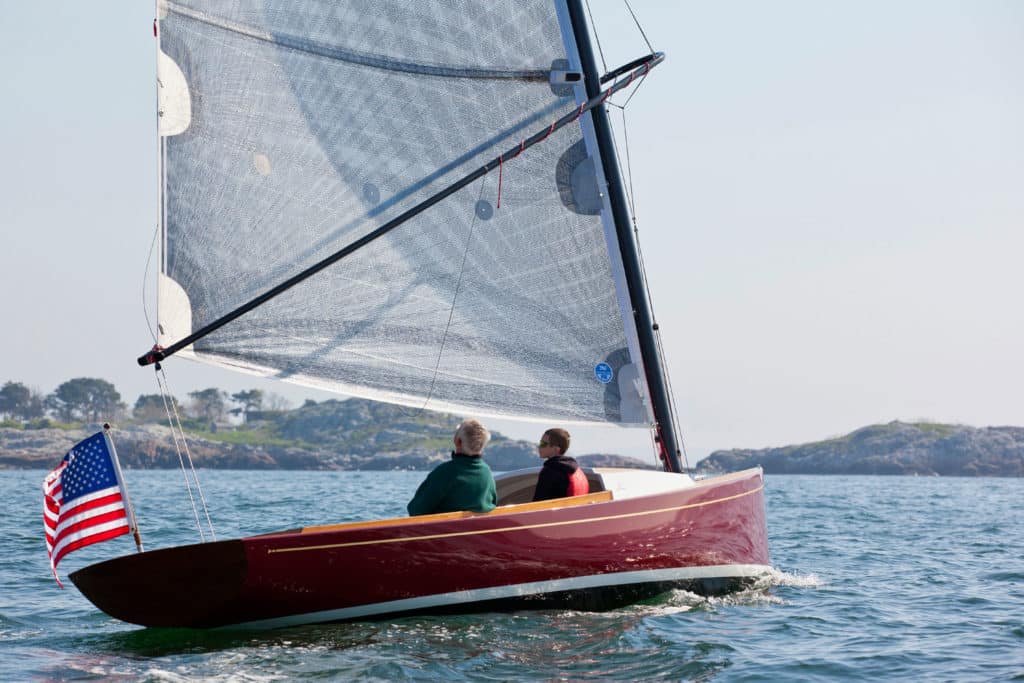
If you have an eye for elegant lines and your heart goes pitter-patter over just the right amount of overhang beneath a counter transom, the Marblehead 22 daysailer, designed by Doug Zurn and built by Samoset Boatworks in Boothbay, Maine, will definitely raise your pulse. Traditional-looking above the waterline and modern beneath, the cold-molded hull sports a deep bulb keel and a Hall Spars carbon-fiber mast with a wishbone rig and square-top main. The 11-foot-9-inch cockpit can seat a crowd, and a small cuddy forward will let you stow your friends’ gear for the day. samosetboatworks.com
Catalina 22 Sport
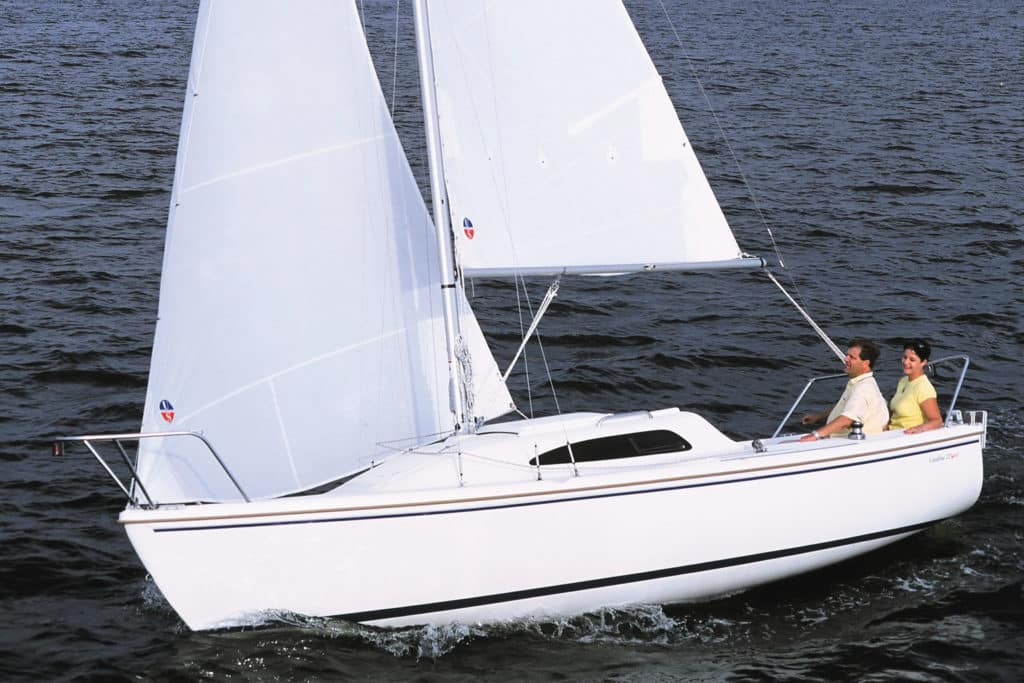
Many a harbor plays host to an active fleet of Catalina 22s, one of the most popular small sailboats over the years, given its basic amenities and retractable keel, which allows it to be easily trailered. Recently, the company introduced the Catalina 22 Sport, an updated design that can compete with the older 22s. The boat features a retractable lead keel; a cabin that can sleep four, with a forward hatch for ventilation; and a fractional rig with a mainsail and a roller-furling jib. Lifelines, a swim ladder, and an engine are options, as are cloth cushions; vinyl cushions are standard. The large cockpit will seat a crowd or let a mom-and-pop crew stretch out and enjoy their sail. It’s clear why the Catalina 22 is one of the best sailboats under 25 feet. catalinayachts.com
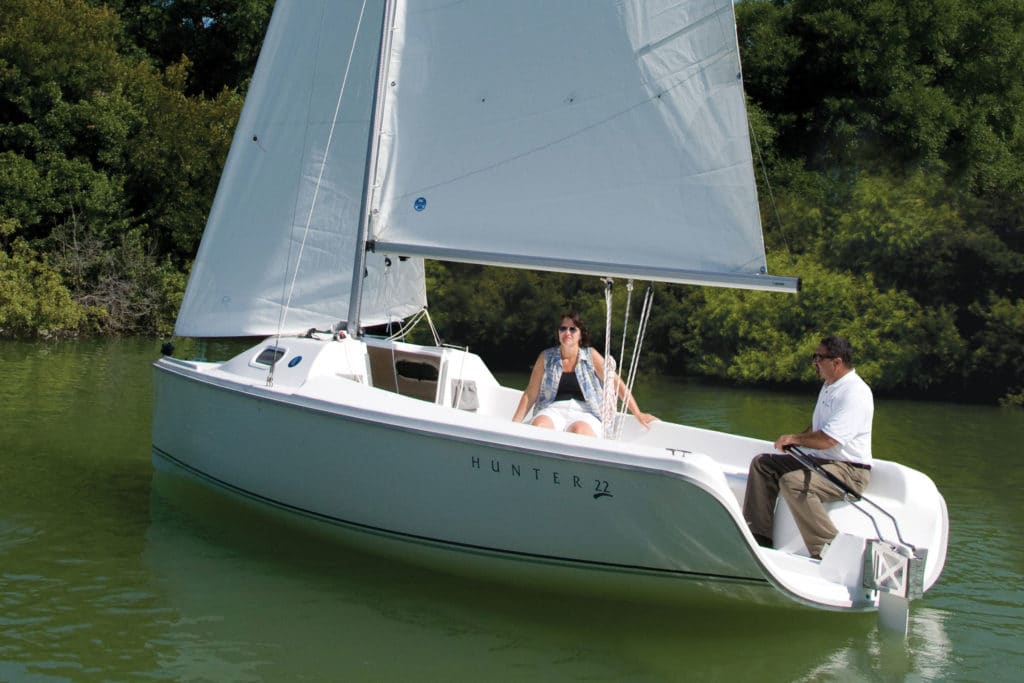
With its large, open-transom cockpit and sloop rig, the Hunter 22 makes a comfortable daysailer for family and friends. But with its cuddy cabin, twin bunks, optional electrical system, opening screened ports, and portable toilet, a parent and child or a couple could comfortably slip away for an overnight or weekend. Add in the optional performance package, which includes an asymmetric spinnaker, a pole, and a mainsheet traveler, and you could be off to the races. The boat features a laminated fiberglass hull and deck, molded-in nonskid, and a hydraulic lifting centerboard. Mount a small outboard on the stern bracket, and you’re set to go. marlow-hunter.com
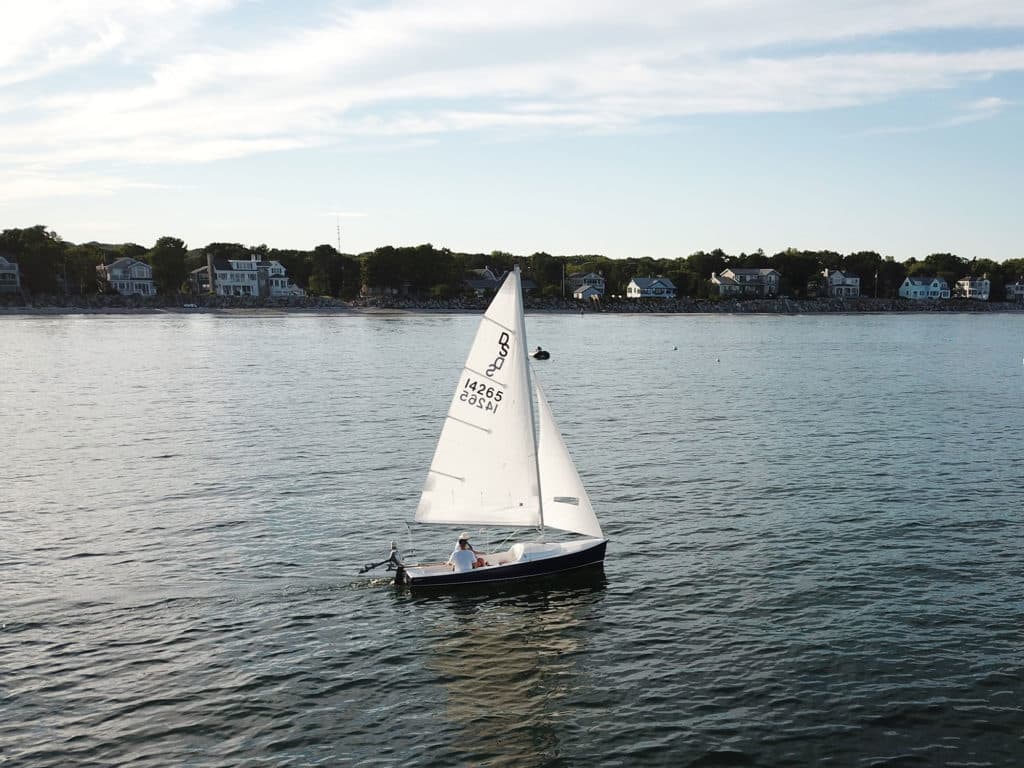
Not sure whether you want to race, cruise or just go out for an afternoon sail? Since 1958, sailors have been having a ball aboard the Uffa Fox/George O’Day-designed Daysailer. Fox, who in the 1950s was on the cutting edge of planning-dinghy design, collaborated with Fall River, Massachusetts boatbuilder O’Day Corp. to build the 16-foot Daysailer, a boat that features a slippery hull and a small cuddy cabin that covers the boat roughly from the mast forward. Thousands of Daysailers were built by various builders, and they can be found used for quite affordable prices. There are active racing fleets around the US, and new Daysailers are still in production today, built by Cape Cod Ship Building. capecodshipbuilding.com
BayRaider from Swallow Boats
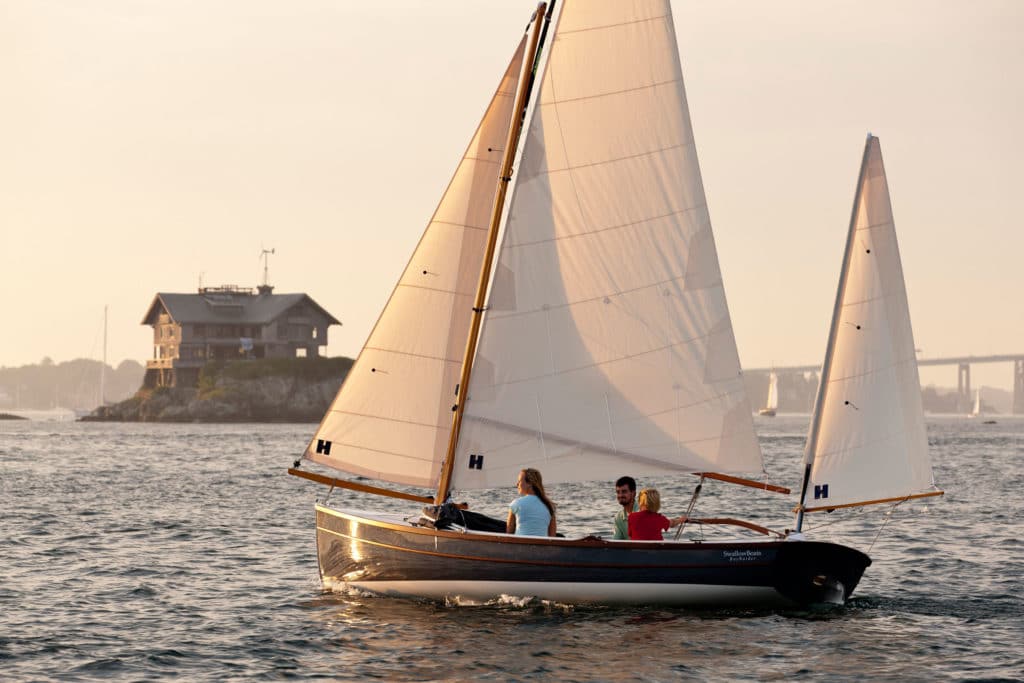
Easy to rig and trailer, the BayRaider from England’s Swallow Yachts is a relative newcomer to the small-boat market in the United States. Nearly all of its 19 feet 9 inches is open cockpit, though a spray hood can be added to keep the forward sections dry. The BayRaider is ketch-rigged with a gunter-style mainmast. The topmast and mizzen are both carbon-fiber, which is an option for the mainmast as well. The BayRaider can be sailed with a dry hull in lighter conditions or with 300 pounds of water ballast to increase its stability. With the centerboard and hinged rudder raised, the boat can maneuver in even the thinnest water.
$28,900, (904) 234-8779, swallowyachts.com
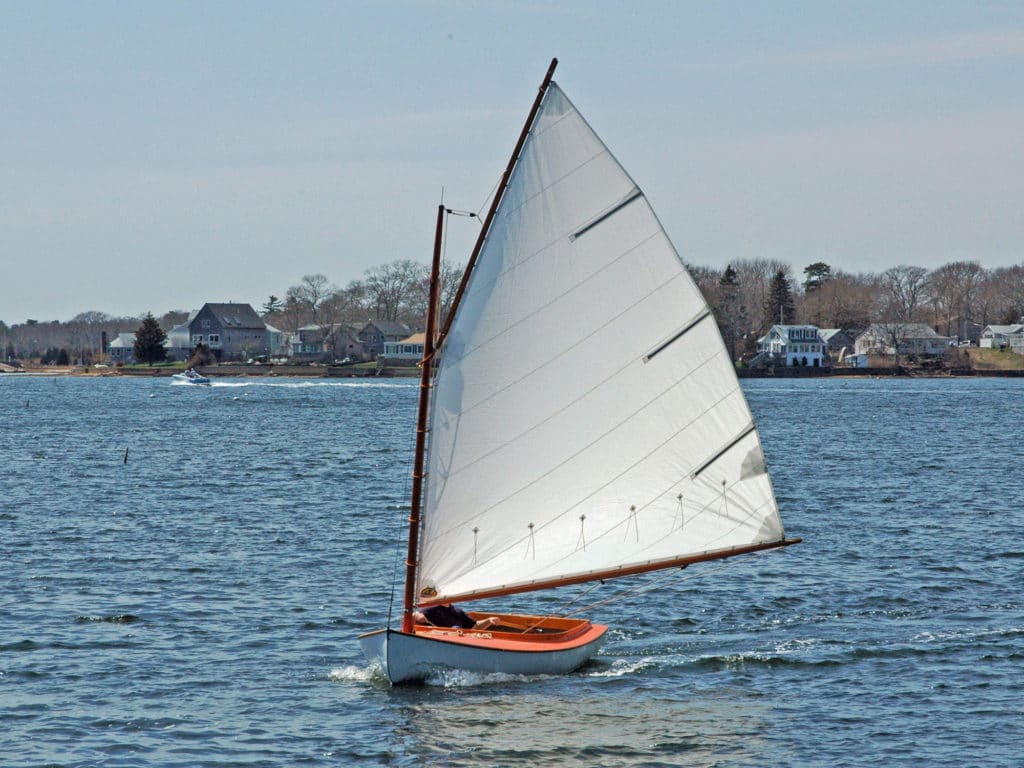
Big fun can come in small packages, especially if your vessel of choice happens to be the 12 ½-foot Beetle Cat. Designed by John Beetle and first built in 1921, the wooden shallow draft sailboat is still in production today in Wareham, Massachusetts at the Beetle Boat Shop. With a draft of just 2 feet, the boat is well-suited for shallow bays, but equally at home in open coastal waters. The single gaff-rigged sail provides plenty of power in light air and can be quickly reefed down to handle a blow. In a word, sailing a Beetle Cat is fun. beetlecat.com
West Wight Potter P 19
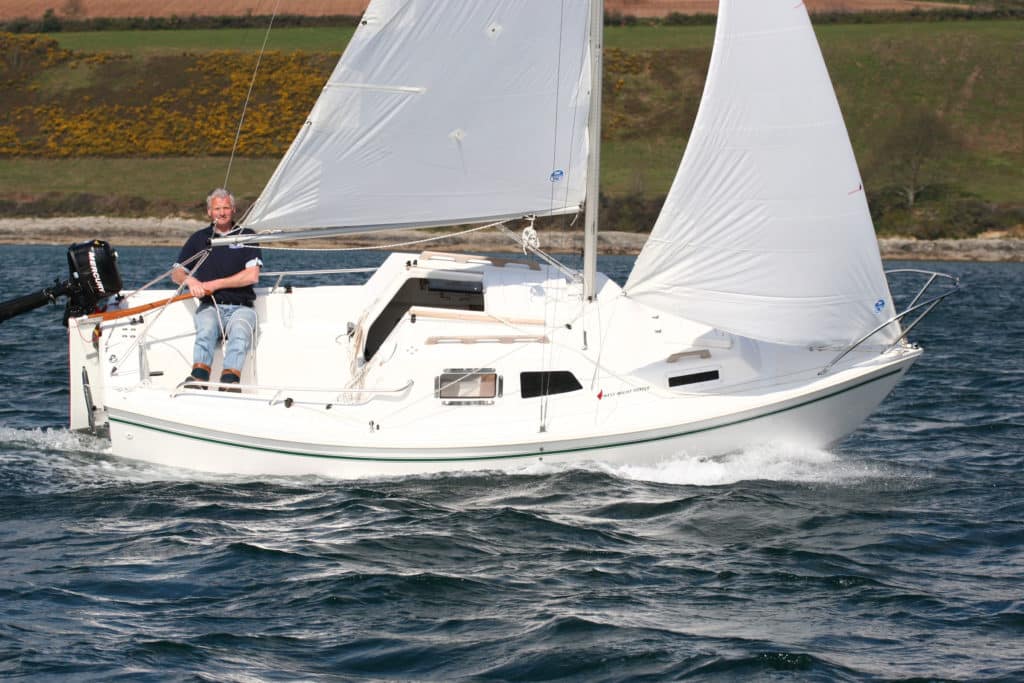
With berths for four and a workable galley featuring a cooler, a sink, and a stove, West Wight Potter has packed a lot into its 19-foot-long P 19. First launched in 1971, this is a line of boats that’s attracted a true following among trailer-sailors. The P 19′s fully retractable keel means that you can pull up just about anywhere and go exploring. Closed-cell foam fore and aft makes the boat unsinkable, and thanks to its hard chine, the boat is reportedly quite stable under way. westwightpotter.com
NorseBoat 17.5
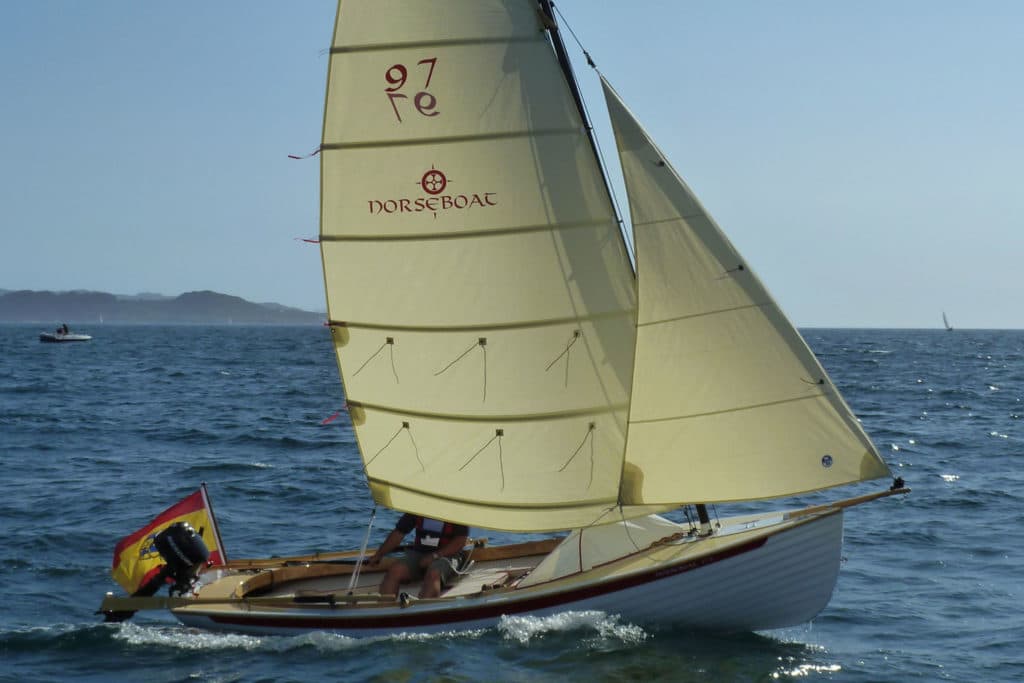
Designed for rowing and sailing (a motor mount is optional), the Canadian-built NorseBoat 17.5—one of which was spotted by a CW editor making its way through the Northwest Passage with a two-man crew—features an open cockpit, a carbon-fiber mast, and a curved-gaff rig, with an optional furling headsail set on a sprit. The lapstrake hull is fiberglass; the interior is ply and epoxy. The boat comes standard with two rowing stations and one set of 9-foot oars. The boat is designed with positive flotation and offers good load-carrying capacity, which you could put to use if you added the available canvas work and camping tent. NorseBoats offers a smaller sibling, the 12.5, as well; both are available in kit form.
$19,000, (902) 659-2790, norseboat.com
Montgomery 17
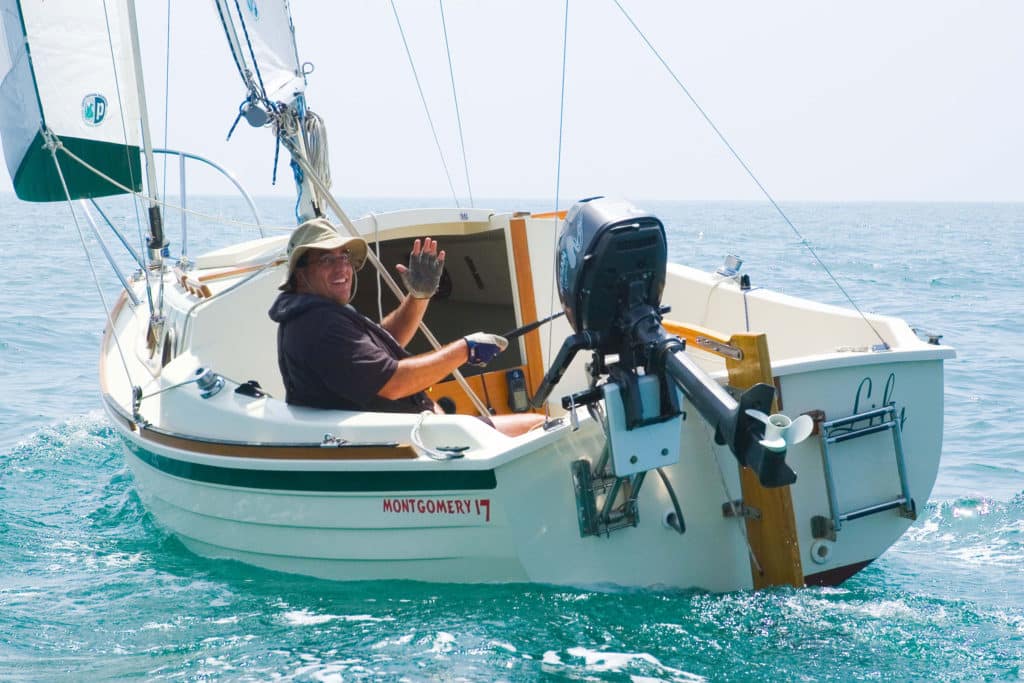
Billed as a trailerable pocket cruiser, the Montgomery 17 is a stout-looking sloop designed by Lyle Hess and built out of fiberglass in Ontario, California, by Montgomery Boats. With a keel and centerboard, the boat draws just under 2 feet with the board up and can be easily beached when you’re gunkholing. In the cuddy cabin you’ll find sitting headroom, a pair of bunks, a portable toilet, optional shore and DC power, and an impressive amount of storage space. The deck-stepped mast can be easily raised using a four-part tackle. The builder reports taking his own boat on trips across the Golfo de California and on visits to California’s coastal islands. Montgomery makes 15-foot and 23-foot models, as well. If you’re in search of a small sailboat with a cabin, the Montgomery 17 has to be on your wish list.
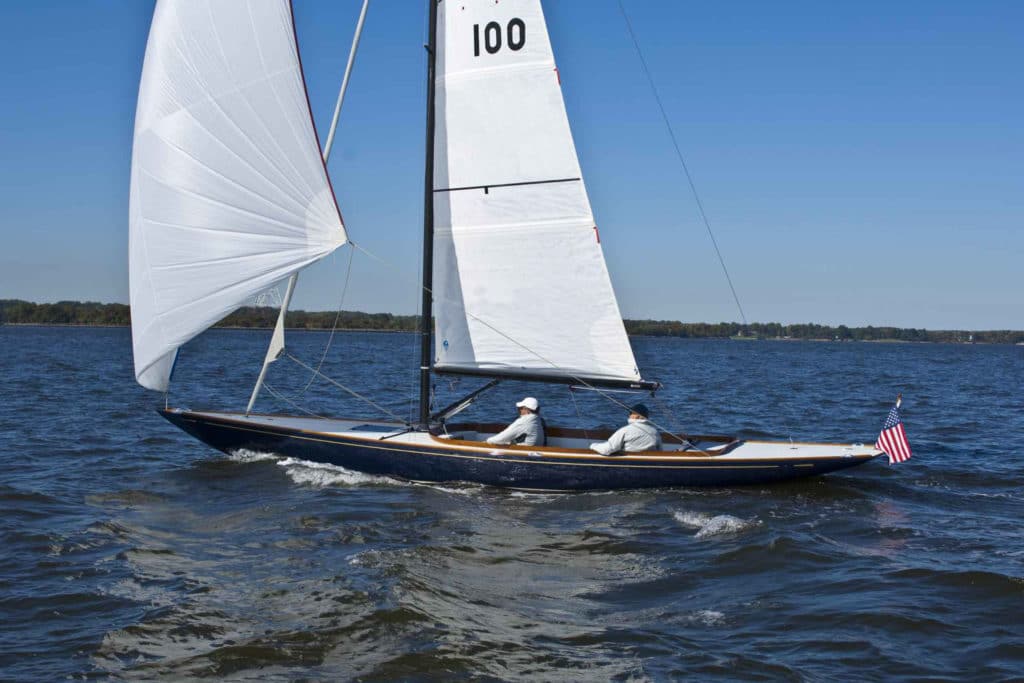
With long overhangs and shiny brightwork, the CW Hood 32 is on the larger end of the daysailer spectrum. Designers Chris Hood and Ben Stoddard made a conscious decision to forego a cabin and head in favor of an open cockpit big enough to bring 4 or 5 friends or family out for an afternoon on the water. The CW Hood 32 is sleek and graceful through the water and quick enough to do some racing, but keeps things simple with a self-tacking jib and controls that can be lead back to a single-handed skipper. A top-furling asymmetrical, electric sail drive and Torqeedo outboard are all optional. The CW Hood 32 makes for a great small family sailboat. cwhoodyachts.com
Sun Cat from Com-Pac
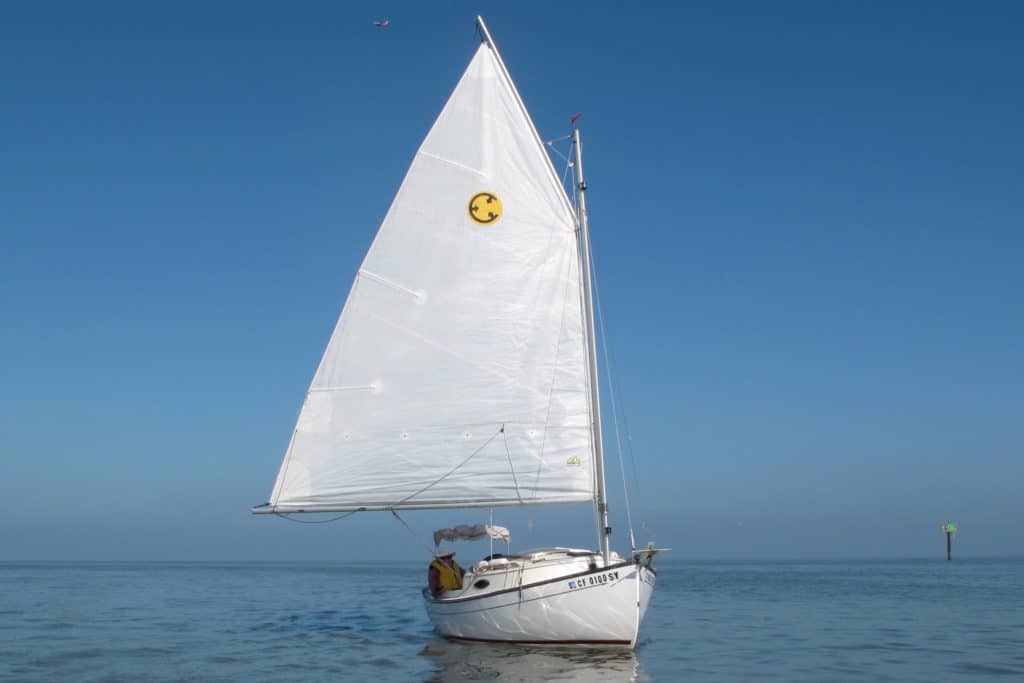
Shallow U.S. East Coast bays and rock-strewn coasts have long been graced by cat boats, whose large, gaff-rigged mainsails proved simple and powerful both on the wind and, better yet, when reaching and running. The 17-foot-4-inch Sun Cat, built by Com-Pac Yachts, updates the classic wooden cat with its fiberglass hull and deck and the easy-to-step Mastender Rigging System, which incorporates a hinged tabernacle to make stepping the mast a one-person job. If you want a personal sailboat ideal for solo sailing, the Sun Can is a great choice. Belowdecks, the twin 6-foot-5-inch berths and many other features and amenities make this cat a willing weekender.
$19,800, (727) 443-4408, com-pacyachts.com
Catalina 16.5
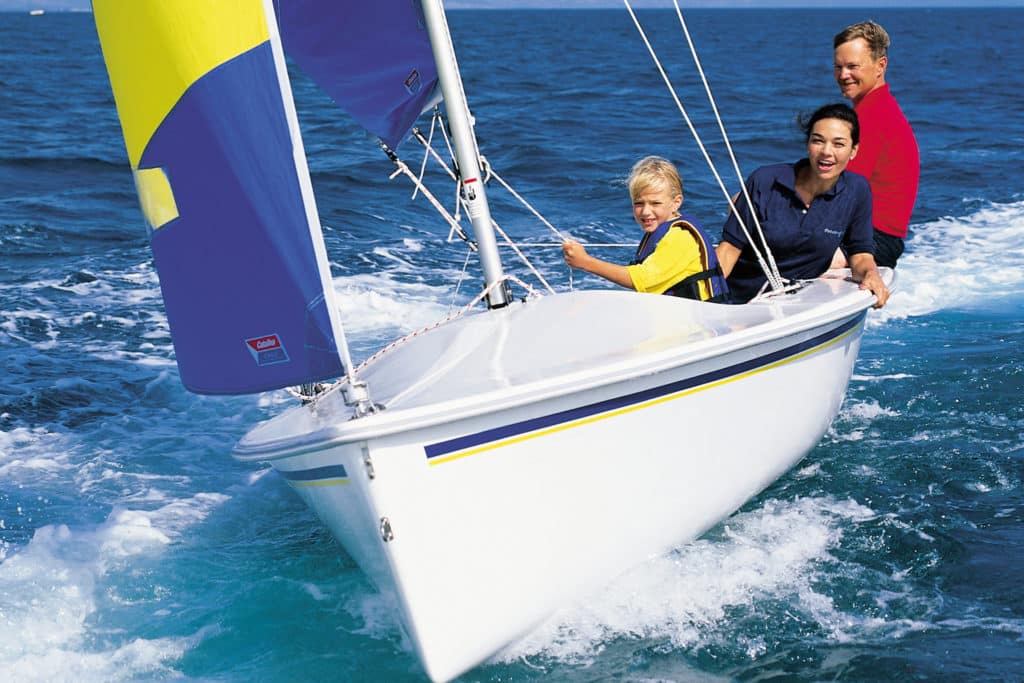
The Catalina 16.5 sits right in the middle of Catalina Yachts’ line of small sailboats, which range from the 12.5 to the 22 Capri and Sport, and it comes in both an easy-to-trailer centerboard model and a shoal-draft fixed-keel configuration. With the fiberglass board up, the 17-foot-2-inch boat draws just 5 inches of water; with the board down, the 4-foot-5-inch draft suggests good windward performance. Hull and deck are hand-laminated fiberglass. The roomy cockpit is self-bailing, and the bow harbors a good-sized storage area with a waterproof hatch. catalinayachts.com
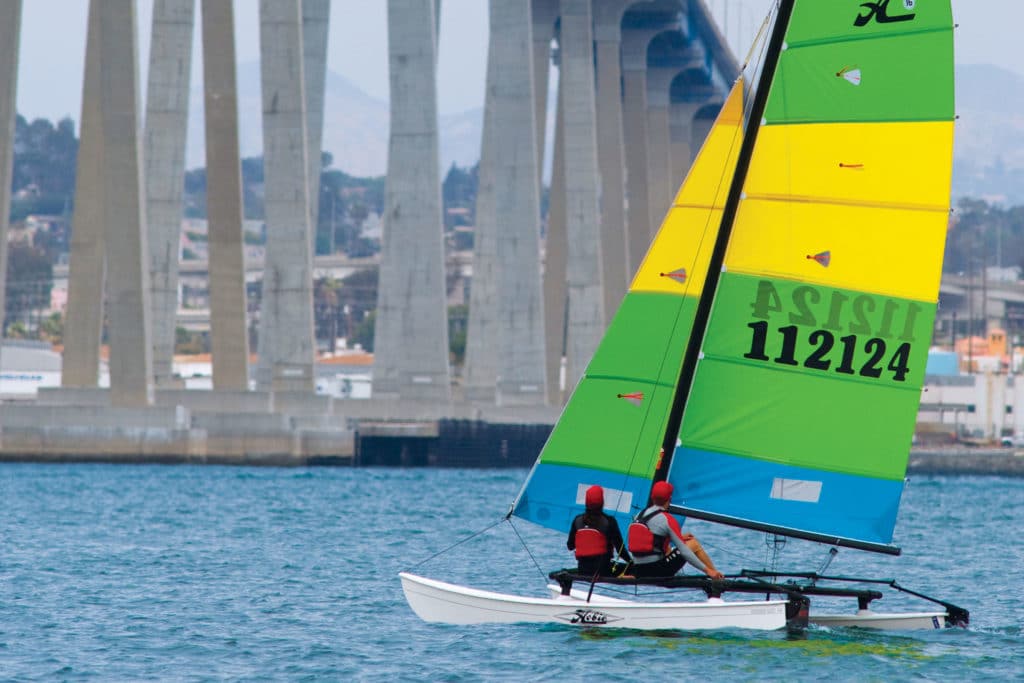
No roundup of best small sailboats (trailerable and fun too) would be complete without a mention of the venerable Hobie 16, which made its debut in Southern California way back in 1969. The company has introduced many other multihulls since, but more than 100,000 of the 16s have been launched, a remarkable figure. The Hobie’s asymmetric fiberglass-and-foam hulls eliminate the need for daggerboards, and with its kick-up rudders, the 16 can be sailed right up to the beach. Its large trampoline offers lots of space to move about or a good place to plant one’s feet when hanging off the double trapezes with a hull flying. The boat comes with a main and a jib; a spinnaker, douse kit, trailer, and beach dolly are optional features. hobiecat.com
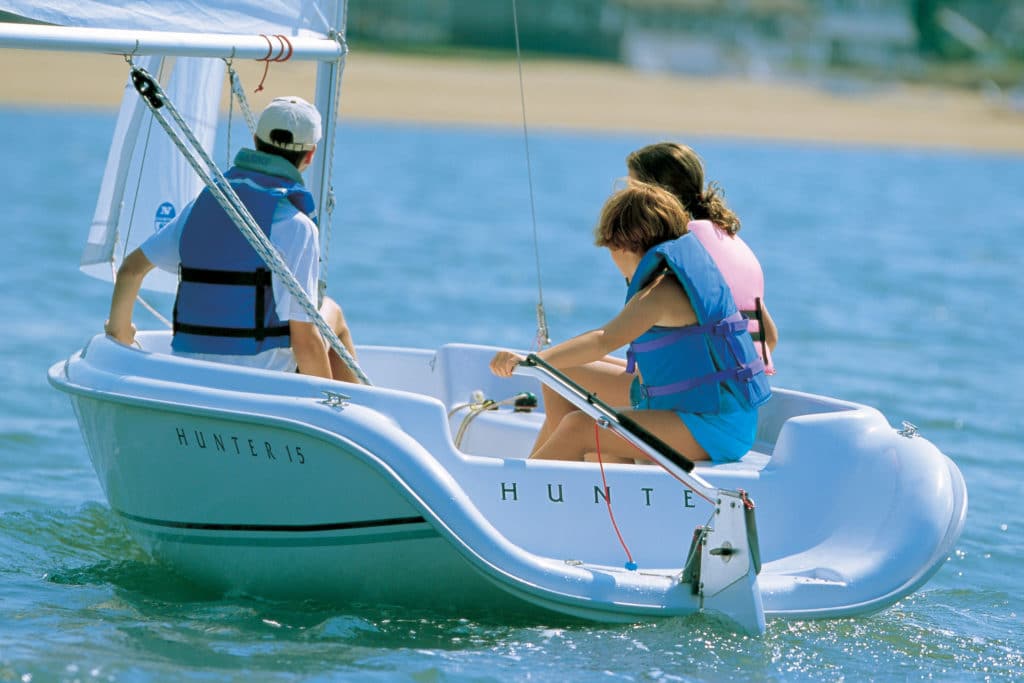
Novice sailors or old salts looking for simplicity could both enjoy sailing the Hunter 15. With a fiberglass hull and deck and foam flotation, the boat is sturdily built. The ample freeboard and wide beam provide stability under way, and the heavy-duty rubrail and kick-up rudder mean that you won’t have to worry when the dock looms or the going grows shallow. Both the 15 and its slightly larger 18-foot sibling come standard with roller-furling jibs.
$6,900/$9,500 (boat-show prices for the 15 and 18 includes trailers), (386) 462-3077, marlow-hunter.com
Super Snark
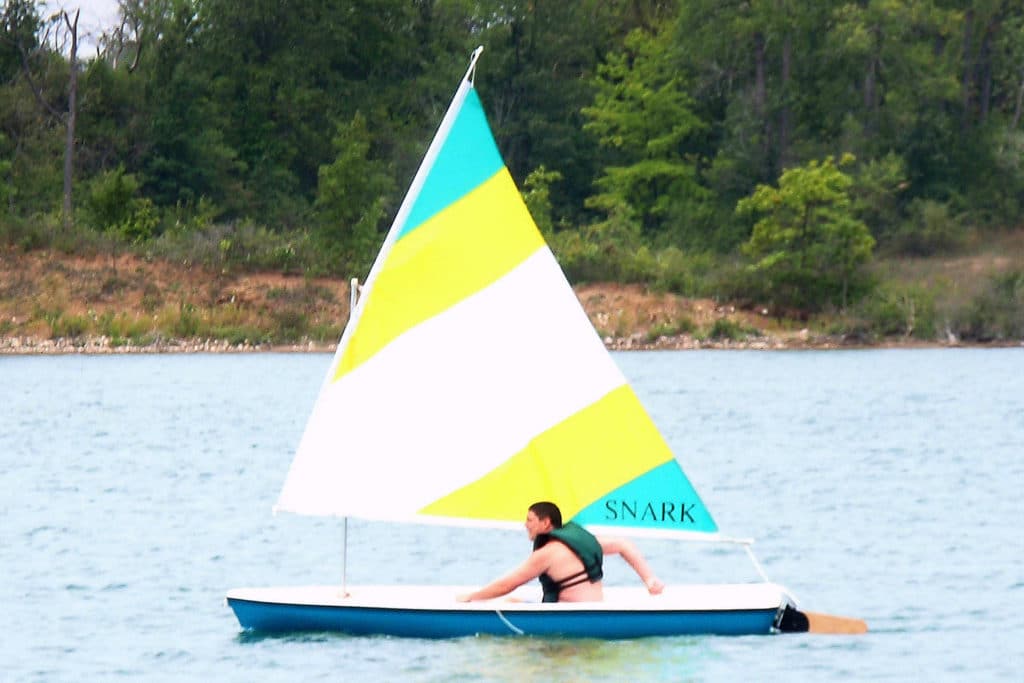
Under various owners, the Snark brand of sailboats, now built by Meyers Boat Co., has been around since the early 1970s. The Super Snark, at 11 feet, is a simple, easily car-topped daysailer that’s fit out with a lateen rig and sail. Billed as unsinkable, the five boats in the company’s line are built with E.P.S. foam, with the external hull and deck vacuum-formed to the core using an A.B.S. polymer. The Super Snark weighs in at 50 pounds, and with a payload capacity of 310 pounds, the boat can carry two.
$970, (800) 247-6275, meyersboat.com
Norseboat 21.5
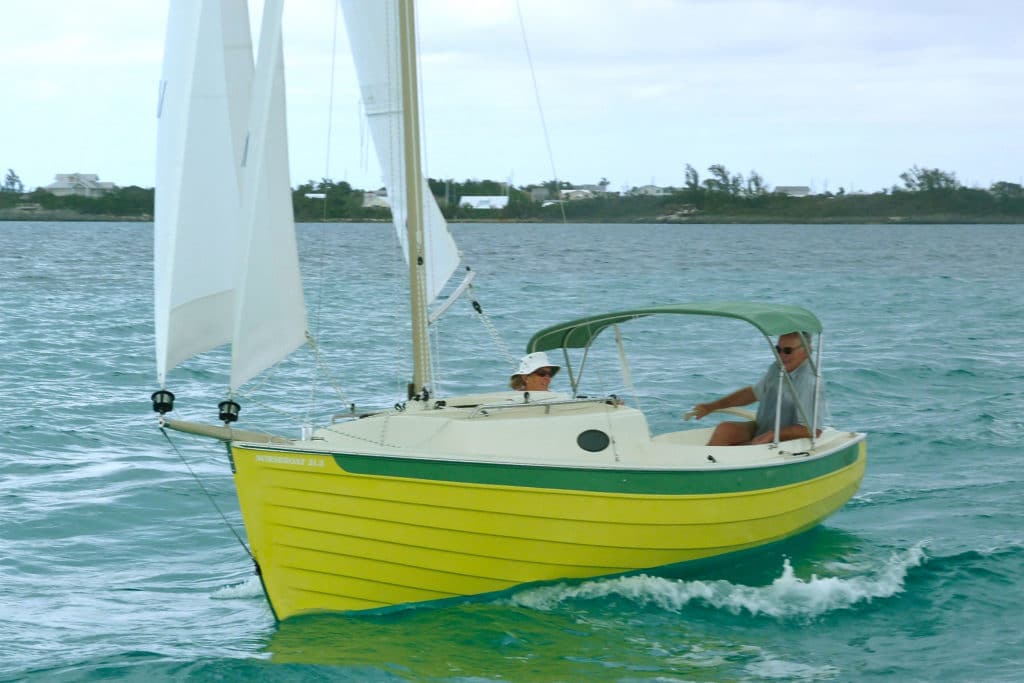
Built in Canada, the NorseBoat 21.5 is a rugged looking craft that comes in a couple of configurations: one with an open cockpit and small doghouse, and another with a smaller cockpit and cabin that houses a double berth for two adults and optional quarter berths for the kids. Both carry NorseBoat’s distinctive looking carbon fiber gaff-rigged mast with main and jib (a sprit-set drifter is optional), and come with a ballasted stub keel and centerboard. Because of its lightweight design, the boat can be rowed and is easily trailered.
$36,000 (starting), 902-659-2790, norseboat.com
Flying Scot
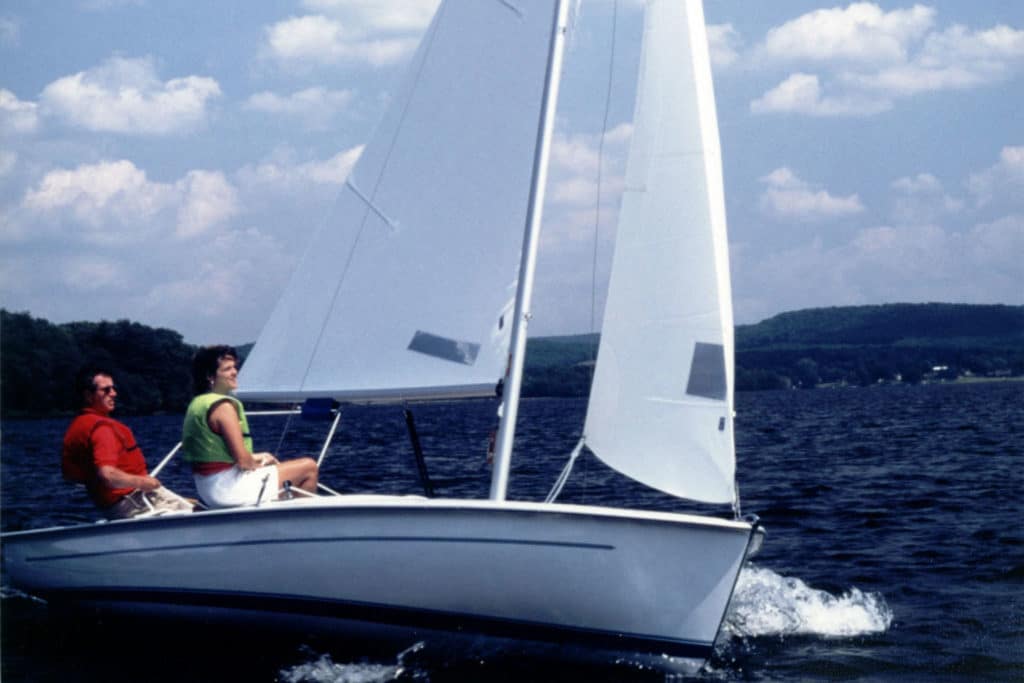
Talk about time-tested, the 19-foot Flying Scot has been in production since 1957 and remains a popular design today. Sloop rigged, with a conventional spinnaker for downwind work, the boat is an easily sailed family boat as well as a competitive racer, with over 130 racing fleets across the U.S. Its roomy cockpit can seat six to eight, though the boat is often sailed by a pair or solo. Hull and deck are a fiberglass and balsa core sandwich. With the centerboard up, the boat draws only eight inches. Though intended to be a daysailer, owners have rigged boom tents and berths for overnight trips, and one adventurous Scot sailor cruised his along inland waterways from Philadelphia to New Orleans.
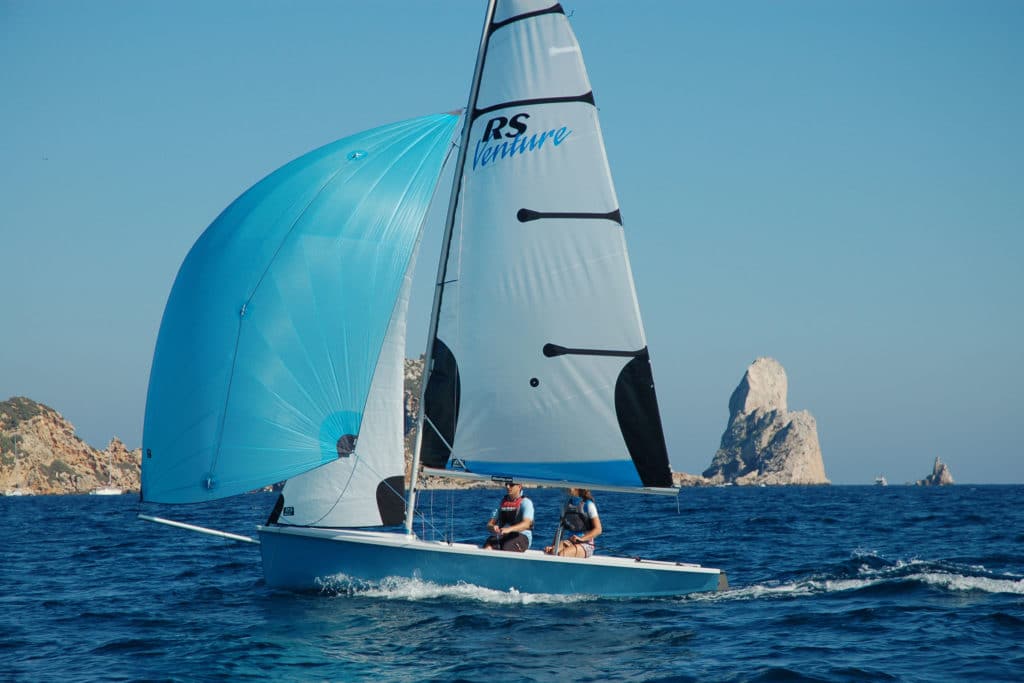
Known primarily for its line of racing dinghys, RS Sailing also builds the 16-foot, 4-inch Venture, which it describes as a cruising and training dinghy. The Venture features a large, self-draining cockpit that will accommodate a family or pack of kids. A furling jib and mainsail with slab reefing come standard with the boat; a gennaker and trapeze kit are options, as is an outboard motor mount and transom swim ladder. The deck and hull are laid up in a fiberglass and Coremat sandwich. The Venture’s designed to be both a good performer under sail, but also stable, making it a good boat for those learning the sport.
$14,900, 203-259-7808, rssailing.com
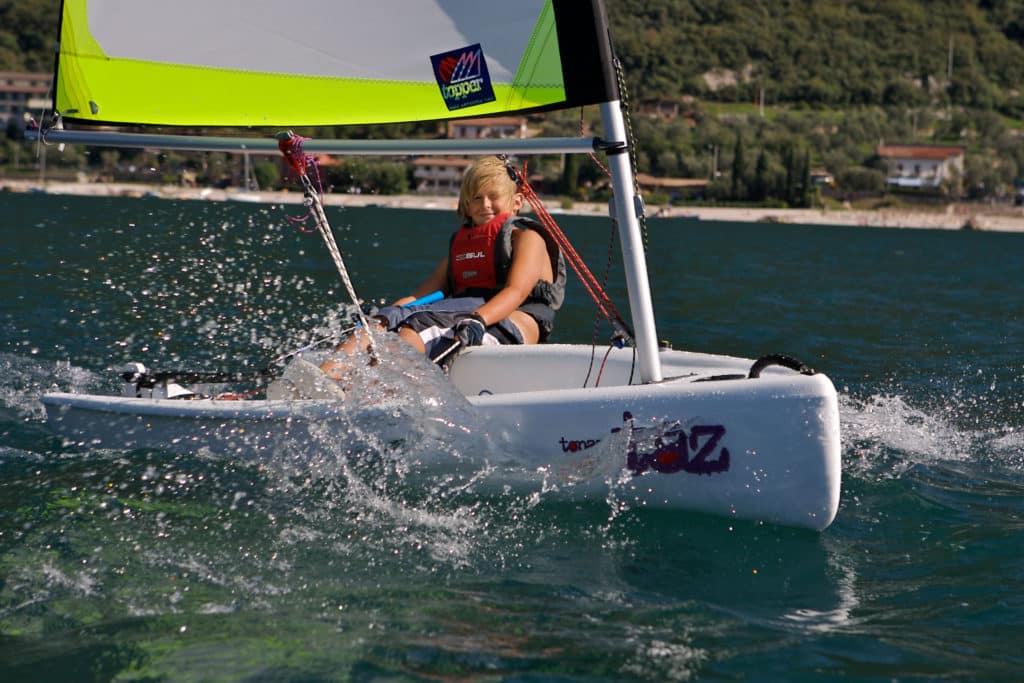
Topper makes a range of mono- and multihull rotomolded boats, but the model that caught one editor’s eye at Strictly Sail Chicago was the Topaz Taz. At 9 feet, 8 inches LOA and weighing in at 88 pounds, the Taz is not going to take the whole crowd out for the day. But, with the optional mainsail and jib package (main alone is for a single child), the Taz can carry two or three kids or an adult and one child, and would make a fun escape pod when tied behind the big boat and towed to some scenic harbor. The hull features Topper’s Trilam construction, a plastic and foam sandwich that creates a boat that’s stiff, light, and durable, and shouldn’t mind being dragged up on the beach when it’s time for a break.
$2,900 (includes main and jib), 410-286-1960, topazsailboats.com
WindRider WRTango
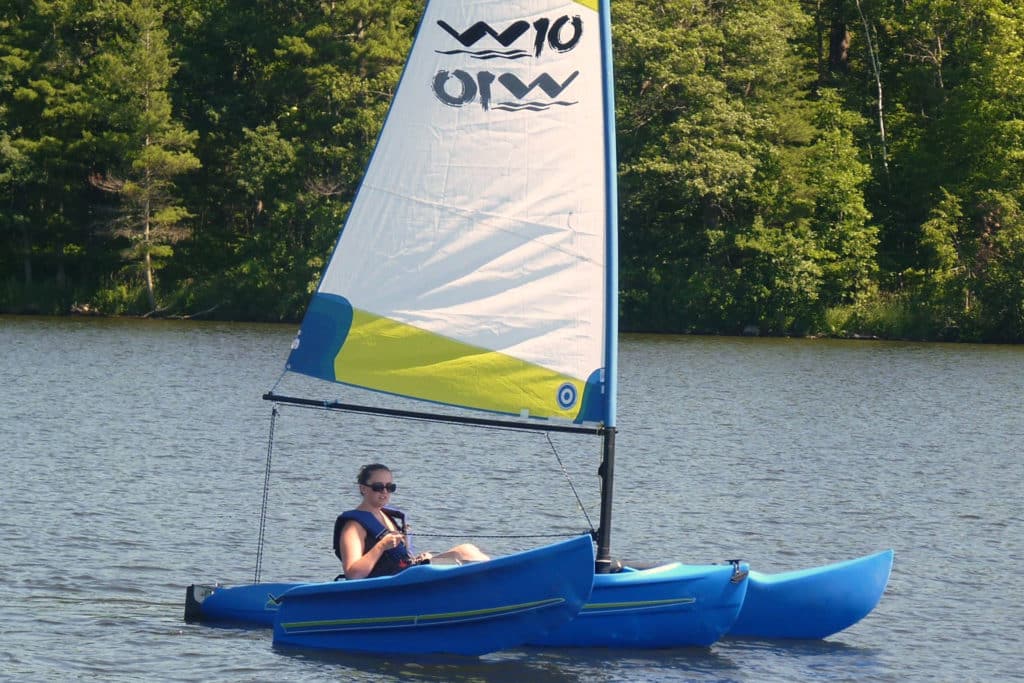
WRTango, a fast, sturdy, 10-foot trimaran that’s easy to sail, is the newest portable craft from WindRider International. It joins a line that includes the WR16 and WR17 trimarans. The Tango features forward-facing seating, foot-pedal steering, and a low center of gravity that mimics the sensation of sitting in a kayak. It weighs 125 pounds (including the outriggers and carbon-fiber mast), is extremely stable, and has single-sheet sail control. The six-inch draft and kick-up rudder make it great for beaching, while the hull and outriggers are made of rotomolded polyethylene, so it can withstand running into docks and being dragged over rocks.
$3,000, 612-338-2170, windrider.com
- More: 21 - 30 ft , Boat Gallery , day sailing , dinghy , Sailboat Reviews , Sailboats , under 20 ft
- More Sailboats
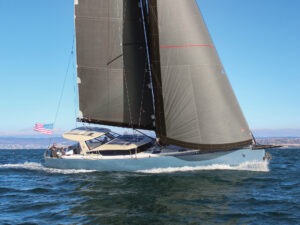
New to the Fleet: Pegasus Yachts 50

Balance 442 “Lasai” Set to Debut

Sailboat Review: Tartan 455

Meet the Bali 5.8
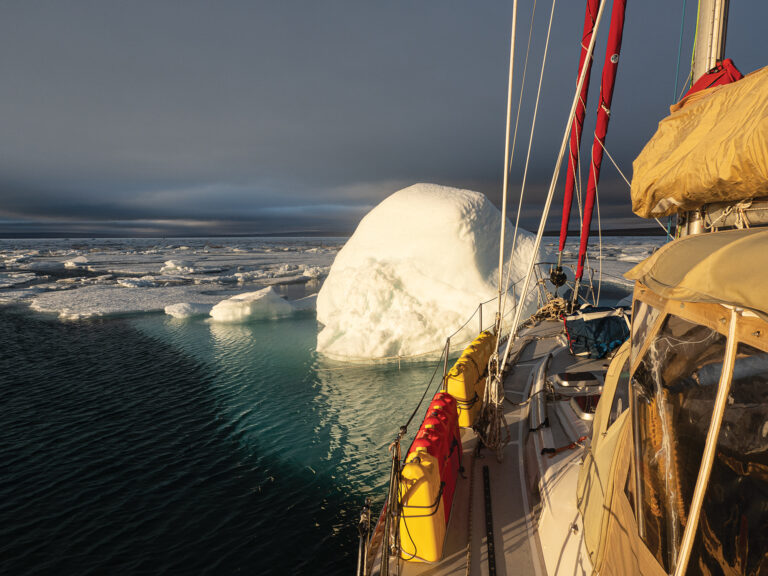
Cruising the Northwest Passage

A Legendary Sail

10 Best Sailing Movies of All Time
- Digital Edition
- Customer Service
- Privacy Policy
- Email Newsletters
- Cruising World
- Sailing World
- Salt Water Sportsman
- Sport Fishing
- Wakeboarding
Better Sailing

Best Sailboats to Singlehand
Sailing alone can be an extraordinary experience for many boaters. Many have attempted to sail on long passages and explore the oceans. But, a common concern is, which one is the right boat to sail single-handed? We’ll find out together in this article. Fortunately, there are many suitable seaworthy vessels for one person. In this article, I list you the best boats to single-hand as well as find out what makes them appropriate for single-handing. These boats range from small lake dinghies all the way to comfortable cruisers capable of oceanic crossings. So, keep reading!
A Few Things About Single-Handed Sailing
There are many boats that perform particularly well for shorthanded sailing. However, the fact is that the structures on a boat have a greater effect on its suitability rather than the boat’s construction. Main features regarding single-handed sailing include easy sail controls, including the ability for one person to quickly tuck a reef in. And, let’s not forget the ability to easily change the sheets and the mainsheet traveller. If you’re looking for a boat to short-handed sail, start by looking at the reefing and sail handling systems, as well as the pilot’s specifications. It’s a great advantage to be able to reach both mainsheet and the primary winches from the helm. But, when sailing on long passages then the pilot might be steering for almost 100% of the time.
For shorthanded sailing, many sailors prefer smaller vessels. This point has a lot of sense because their compact size, ease in navigation in a small room, and less complicated structures, make them more simple to sail. But, keep in mind that there are also sailboats of 70ft that are set up to be handled by 1 or 2 persons on deck. In which case, the sailors must be experienced and be able to fix any damaged system. So, if a vessel is properly set up it can be easily handled by one or two experienced sailors, no matter its size.
Boats made from the early 1990s onwards are more stable than their ancestors, as well as deep draught low center of gravity keels. These are a great choice for single-handing. The added stability means a reduced need to reef which facilitates the overall sailing experience and performance.
In any case, the below-mentioned boats, and similar others in each respective range, form great choices for single-handed sailing. They all offer easy short-handling for either beginners or experienced. And also for those that want to experience calm sailing to those seeking a fast and responsive, but ultimately safe, vessel.
Handling and Set-up
First of all, when solo sailing, it’s important to focus on the ease of handling your boat. This is because you will be in charge of all roles; skipper, navigator, bow-person, dial trimmer, engineer, and chef! So, what you want to achieve here is making all these roles simpler in order to facilitate all tasks.
So, it’s advisable to take your boat out on a calm sea and experience all possible motions of sailing. Like you were racing or cruising but also hoisting sails, trimming, steering, and navigating. Like this, you will be able to see if any problems come up. The most common problem sailors experience is reefing the mainsail by themselves. Also, the spinnaker pole might be too much to handle by yourself or find it difficult to reach the sheeting positions. In other words, if you’ve never sailed short-handed before, this first experience might seem challenging. And, some things are really important to handle like reaching the main traveler while steering. But, don’t get discouraged! Consider taking notes while onboard, and start finding new ways of facilitating your voyage.
Some simple changes include shifting a halyard clutch. But, there are more challenging ones like switching to a single-line reefing system. Wherever feasible, a single-line reef system is preferable. But, adding a reef tack line and getting back to the cockpit can be even more convenient and require less line that will probably tangle in the cockpit. Keep in mind that the most important factor for single-handed sailing is to make your boat easier to sail. So, now let’s see the best boats for single-handed sailing!
The Hanse 371 was built from 1999 until the mid-2000s. The boat offered a selection of either deep or shallow low center of gravity fin keels. These were joined with the hull and a long waterline. Below the deck, you can choose between 2 or 3 cabin layouts with a comfortable galley. Hanse 371 benefits from self-tacking jibs so when tacking all you have to do is spin the wheel. And, in case you’re sailing on autopilot you just press a few buttons and you’re good to go.
In addition, you can increase sail area when reaching in light air with a Code 0 or asymmetric spinnaker. This model maximizes the amount of space and with a reasonable budget. So, with its great interior and performance, the Hanse 371 is a seaworthy vessel that may cost you around $60,000. Most importantly keep in mind that everything is standard and easy to use. Like this, you simplify your life while sailing single-handed.
Jeanneau Sun Fast 3200
The Jeanneau Sunfast 3200 was manufactured with offshore short-handed sailing taken into account since the beginning. This boat is not only a classical sailing boat but also a small and light one that is easy to navigate. Even better, it has the durability and strength to withstand long passages. And, for this reason, they built it specifically for the Trans-Atlantic race. This boat is especially impressive when you sail off the wind, and totally practical and reliable even when sailing alone. This could be due to the fact that the design and setup are mostly constructed for racing. So, it could be ideal for you if you’re looking for a coastal cruiser that’s easy to handle.
Even when sailing downwind, you can easily achieve double figures in terms of speed with this boat. In particular, the Sunfast 3200 features cutting-edge technology to provide you with the best strength-to-weight ratios possible. It has all of the requisite features to easily adapt it to perform admirably as a sailing or racing sailboat. The boat features two double cabins, a chart table, a galley, and a head compartment.

>>Also Read: Best Sailboats Under 20ft
Beneteau Oceanis 62
Let’s now pass to the bigger fellas! As aforementioned, single-handed sailing doesn’t mean you have to choose small sailboats. This is because nowadays single-handed 60+ ft boats aren’t that rare in terms of production, as they were in the past.
Basically, the Beneteau Oceanis 62 meets the modern demands of today’s market and was specifically designed to provide ease of use. In other words, it can be easily handled and operated by a single person. I know that all this space might be a bit exaggerated, but if you’re the kind of person that enjoys being in oceanic solitude while benefiting from having a moving apartment, then this one is for you! Of course, there are more boats of the same size suited for short-handed sailing, like the Hanses, Bavarias, and Jeanneaus. But, you can find a new Oceanis 62 for around $724,500, which is a great price for boats of that size combining both performance and quality.
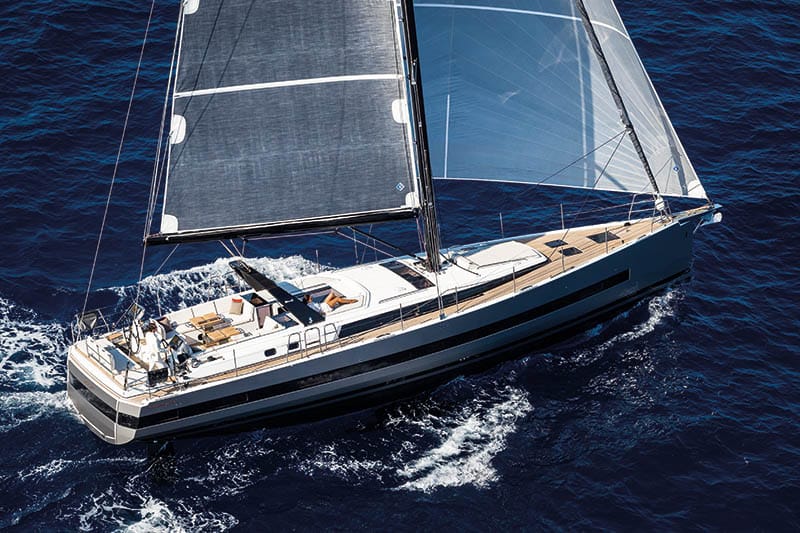
>>Also Read: Is It Dangerous to Sail Around the World?
Hunter Channel 31
From the mid-1980s onwards, this British boatbuilder transitioned from racing to powerful but easy-to-handle small cruisers. As a result, a series of boats has been developed that can sail almost effortlessly without losing handling characteristics.
The deck layout features an effective layout, with an optional self-tacking jib and single-line mainsail. As a short-handed sailor, you’ll benefit from the tiller steering, which allows you to steer with your legs while trimming sails. The accommodation below decks is well-designed and provides considerably more room than the previous Horizon 30 model.
This model, which debuted in 2001, was of higher quality than the majority of Hunter’s other cruising models and greatly focuses on performance. It was also one of the company’s last all-new designs, so it benefited from the most up-to-date design at the time. This was especially apparent in the well-balanced hull shape, which also provided excellent form stability. Joined with high ballast ratios and low center of gravity keels resulted in a boat that doesn’t need continuous trimming to maintain high average speeds or avoid repeated broaching in gusts.
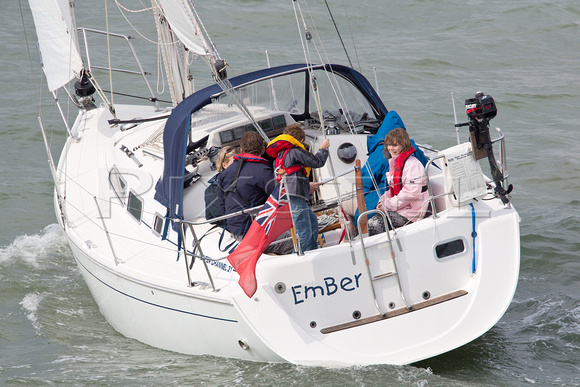
>>Also Read: How Far Can you Sail in One Day?
This is the prototypical short-handed performance boat in several respects. Long-distance single-handed and double-handed sailors love it as well as inshore racing teams. The boat’s offshore reputation has been well established, with many North Atlantic crossings under its belt. Although J/109 is often considered as a planing boat, this 19-year old model is too heavy to be one of that kind. It is basically a moderate all-rounder that offers great performance with the ability for extended surfing when offshore. The boat is also available in a shoal draught form, but it didn’t sell that much.
A great advantage is that the big asymmetric spinnakers can be easily gybed from the cockpit in light airs. And, a poled-out jib can still provide fast downwind speeds with an enviable degree of control in a true wind of more than 20 knots. Almost everyone sailing J/109s short-handed, at least in Europe, hasn’t used the boat’s original overlapping genoas so as to employ blade jibs that are set on roller furling gear.
The only downside is that the boat is expensive for one of this size on the second-hand market. However, its quality of construction and the high standard equipment aren’t going to let you down. Moreover, the interior layout is sparse and has less interior space, although it provides a well-designed and effective two-cabin compartment.
Catalina 315
This is a stylish pocket cruiser that raises the bar for solo sailors by providing exceptional comfort and efficiency. With a hull length of 31′, the Catalina 315 has more interior space than most classics and is still ideal for solo sailing. Rigging the Catalina 315 is a lot simpler with a masthead sloop because it has both an in-mast roller furling mainsail and a roller furling genoa.
Despite the fact that it is a much larger boat, it has a few key features that make all the difference. The split backstays, for example, are excellent for balance and functionality. This is one of the key reasons it was named the 2013 Boat of the Year Best Inshore Cruiser by Cruising World. The boat might surpass your needs when sailing solo, as it is a high-end sailboat with a price tag of more than $175,000. However, if that seems too pricey, you can look for a used model, which will be slightly less expensive.

Pacific Seacraft Flicka 20
The Flicka is a 20-foot sailboat developed and planned for extended cruising and bluewater sailing. The Newport workboats of the 19th century were distinguished by their sweeping sheer, proud bowsprit, blunt bow, broad beam, and low side decks. Flickas by Nor’Star and Pacific Seacraft have withstood the test of time. This is because most Flickas were made with polyester resin or vinlyester resins later on in the production.
For some sailors, this is a disadvantage as you don’t realize just how small the Flicka is until you step into the cockpit. However, it’s a seaworthy vessel and offers a remarkably spacious interior. In addition, the robust tiller is mounted on the transom, thus giving good leverage for steering and freeing up cockpit space. As for the interior, there really is enough standing headroom as well as the open-plan without a full forward bulkhead opens things up. The galley offers all basic equipment and the V-berth is large and comfortable.
On top of that, the Flicka is towable, seaworthy, and you can actually liveaboard. Even though it is a small craft you can still cross the oceans with it. On this one, there’s no denying that everything is within easy reach. At this scale, ergonomics are almost irrelevant. Because of its towability, the fact that it can be parked in your garden, and its short-handed capability, it’s the ideal spontaneous getaway vessel.
Amel 60 definitely got your back while sailing solo in the oceans. The Amel 60 features great advantages and, with its rectangular hull portlights and wraparound windscreen, it takes you on the modern cruising generation.
Fixed bowsprits and plumb bows ensure a modern design and experience. In addition, lines open out into beamy sections aft and benefit from twin rudders. And, since these forms, when paired with the proper buoyancy distribution, can provide a faster hull form, it’s a no-brainer for cruising designs to follow the secondary benefits that come with this fuller form. The watertight bulkheads ensure that the boat won’t sink. Moreover, the cockpit has a sturdy roof and windows, so you’ll be safe no matter the weather. And, the stable hull ensures great handling even in challenging weather conditions.
One of the main benefits is the increased volume, which applies to both the accommodation and the deck lockers. When heeled, twin rudders minimize drag and provide a more balanced feel while underway. However, if they get damaged they provide a redundancy level. The shallower rudders also help in mooring stern-to for those who spend more time in areas like the Mediterranean. In the interior, you get enough space and luxury as well. There’s even a washing machine! So, even if you are an experienced single-handed sailor that wants to benefit from space and performance, then with the $1.5 million price you will get this luxurious boat!
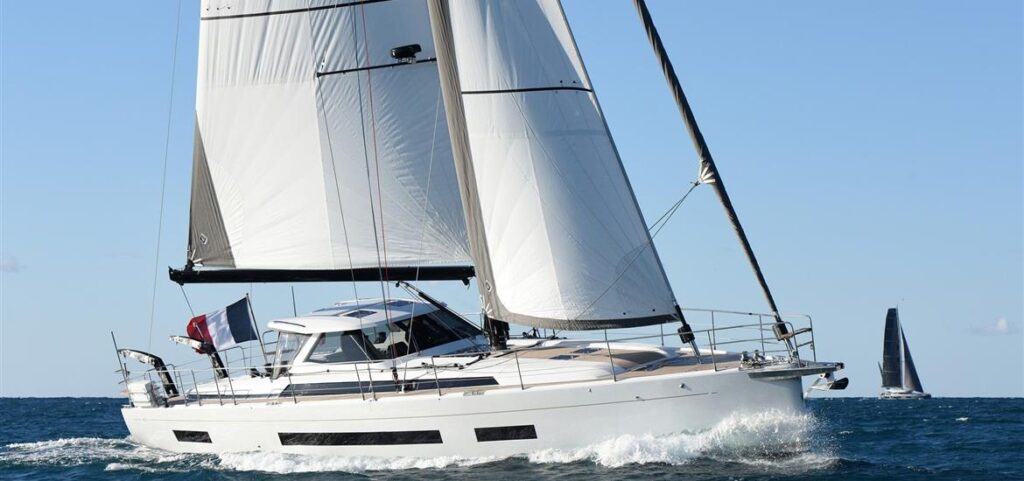
Beneteau 31
As a small cruiser keelboat, this French-designed vessel is predominantly constructed of fiberglass and is ideal for single-handed sailing without minimizing interior space and comfort. Its galley has ample storage and counter space, as well as a sit-down navigation station with a small table. The interior benefits from the straight-lined and elegant thinking of Nauta Design. The comfy seats on either side of a drop-leaf table double the living space. There’s also a spacious athwartship aft-cabin berth and V-berth.
Under power, maneuvering this boat is a breeze, and it’s well worth it for any solo sailor looking for a coastal cruiser. It has a fractional sloop rig, which allows for in-mast furling. This makes it simple to control while also making it strong in light winds. A bow pulpit and an optional asymmetric cruising chute will enhance the performance if you’re sailing the boat off the wind. The new 31 is estimated to cost about $115,000, which is very pricey but well worth it if you want to cruise the globe in this French masterpiece.
Best Sailboats for Solo Sailing – The Bottom Line
Singlehanded sailing is a great achievement in terms of adventure and endurance, especially for lone sailors that cross the oceans. Many experience sleep deprivation, the stress of being alone, and difficult weather conditions that have to be handled by yourself. So, if you decide to set sail for an offshore voyage on your own is a big step to make. And, surely you need a sturdy and seaworthy boat. All the aforementioned boats are considered to be the best cruisers for single-handed sailing. It is up to you to decide which one to choose. This will be determined according to your budget, preferences, needs, and course of your voyage. And, remember that sailing solo learns you to live independently which is a great achievement!
Peter is the editor of Better Sailing. He has sailed for countless hours and has maintained his own boats and sailboats for years. After years of trial and error, he decided to start this website to share the knowledge.
Related Posts

The Ultimate Guide to Choosing the Best Fishing Line for Trolling

Lagoon Catamaran Review: Are Lagoon Catamarans Good?

Best Inboard Boat Engine Brands

Are O’Day Sailboats Good? A Closer Look at a Classic Brand
- Buyer's Guide
- Destinations
- Maintenance
- Sailing Info
Hit enter to search or ESC to close.
Best Small Sailboats for Beginners
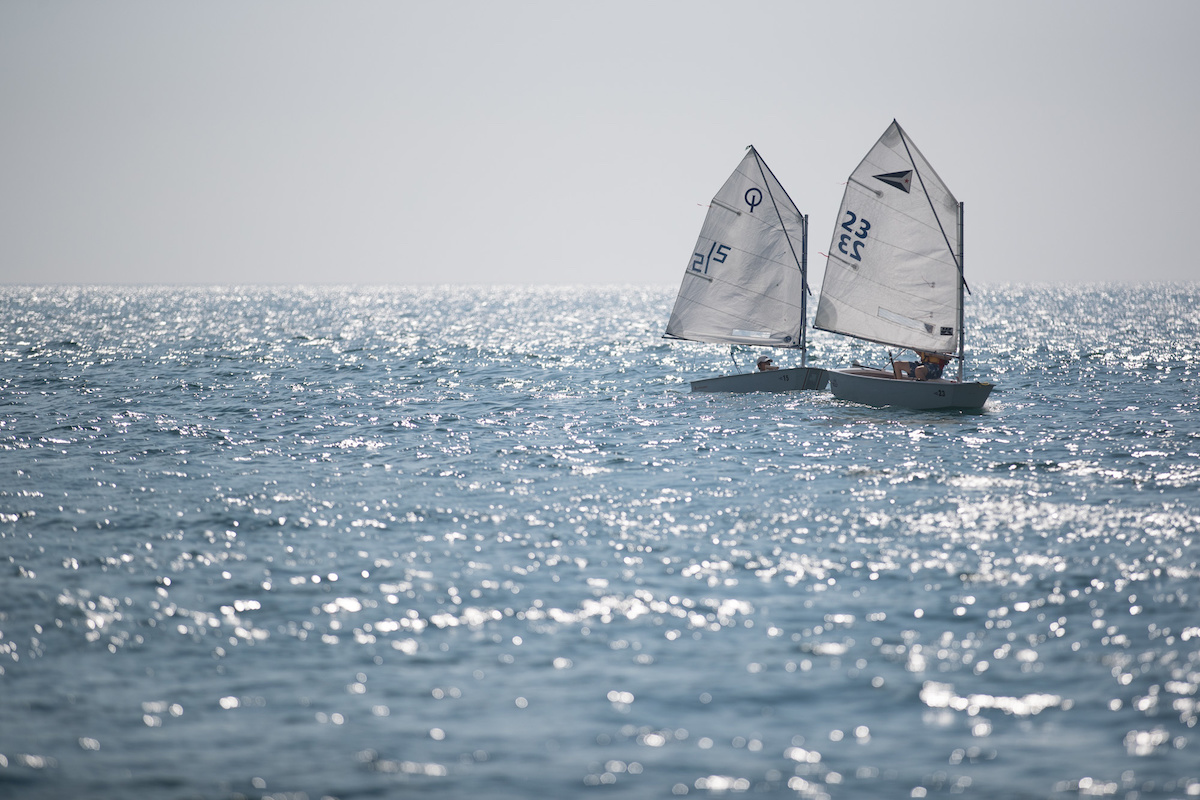
There are a number of classic trainers used by yacht club youth programs as well as techie new designs. Without mentioning specific models and brands, it’s difficult to outline which small boats are best but here are things to look for in good teaching boats.
Some of the best small sailboats for beginners include:
- Boats with tillers steering
- Boats with no winches
- Sailing dinghies
- Small sloops
- Small catamarans
- Rotomolded boats
- Trailerable sailboats
Explore All Sailboat Types
Boats with Tiller Steering
Steering by tiller (rather than a wheel) can make a difference when learning. Tillers are directly connected to the rudder that manages the boat’s direction. Tillers provide quick feedback about the strength and direction of the wind as well as the boat’s turning agility at various speeds.
Boats with No Winches
Boats that require no winches to manage the sheets and halyards are best for youngsters and new sailors. These boats usually don’t experience the same forces on the sails and rigging as larger boats, which can be a handful when the wind starts to blow. Winches are usually replaced with cam or jam cleats, which are easy to use.
Sailing Dinghies
Sailing dinghies are usually rigged with one mast and one sail and offer kids and new sailors simplicity so it’s easy to learn the ropes. Less overwhelming than boats with two sails, dinghies are light and responsive. They also have a shallow draft due to side or centerboards so they can be sailed just about anywhere. In some cases (whether from a wind gust or sudden crew weight shift) sailing dinghies can capsize so students should wear lifejackets and know how to swim. Sailing dinghies are usually sailed by one or two people.
Small Sloops
Small sloops with a mast that carries head and mainsails are the next step so students learn how sails work together. Headsails can be hanked on or attached to a small roller furler. These boats may have some or no winches, which also makes them easier to maintain. These boats can usually be sailed with one to four people.
Some sloops can scale up, providing a more challenging experience for sailors as they develop skills. Certain models can carry spinnakers and larger headsails to teach sail combinations and new sail trim techniques. Others offer the ability to hike out (shift crew weight well outboard to balance the boat against the wind pressure in the sails). This kind of sailing is more advanced.
Small Catamarans
Small catamarans provide extra stability for those who may be nervous about capsizing or aren’t fond of heeling (tipping while sailing). With two hulls providing a wide and stable base, catamarans area ideal for beginners, which may be why they’re often used by resorts as their beach sailing tourist boats. Rigged with one or two sails, small cats are tiller steered and usually have a trampoline that the students sit on and sail.
Rotomolded Boats
Small rotomolded boats are very forgiving due to their durable construction. Unlike fiberglass or wooden boats, rotomolded (a type of plastic construction technique) trainers can bounce off docks or other boats and cause or sustain little damage. Dinghies and catamarans can both be made via rotomolding.
Trailerable Sailboats
Finally, small sailboats that can be trailered to different locations add variety and that makes learning fun. Students can learn to sail in different wind and water conditions and enjoy their boats differently on vacation or with new friends.
Learning to sail involves all the senses and requires a level head and lots of practice and although it can be learned in many ways, the best way is to start with a boat that’s small, simple, safe and durable.
Read Next: Small Boats: What Are My Options?
You Might Also Like:
- Sailing Basics: 10 Nautical & Sailing Terms to Know
- Learning the Basics of Sailing
- Why Sailing?
- Find the Right Boat for Your Lifestyle
- Explore Sailboat Brands
Join Our Newsletter!
Get community news, buying bargains, and how-to guides at your fingertips.

NORDIC TUGS
NORTHERN MARINE
BULLFROG BOATS
MY YACHT WORTH?
- USED YACHTS
FEATURED LISTINGS
YACHTS BY BUILDER
YACHTS BY LOCATION
YACHTS BY TYPE
WHY LIST WITH US
- BUYING A TRAWLER YACHT
- TRAWLER BOAT BUYER'S GUIDE
FT LAUDERDALE
MARINA DEL REY
SAN FRANCISCO BAY
ST AUGUSTINE
VICTORIA B.C.
- SERVICE - PNW
FLOTILLA EVENTS
SEATTLE SAILING ACADEMY
- JOIN OUR TEAM
How Big Of A Sailboat Can One Person Handle?

During all the years I have been sailing, especially as a small-boat sailor, one question invariably comes up. And depending on where the discussion takes place, possible answers are all over the board from well-meaning people accustomed to traditional answers to this classic question.
With social media and the general free-for-all of everything now published, printed, texted, emailed, and discussed on the dock and at boat shows, it seems to be as popular as ever.
Just how large a sailboat can one person sail single handed?
A 40-foot sailboat is the maximum size for one person to be able to single-handedly control safely . It can be successfully argued up or down a couple of feet, based on the experience and abilities of the sailor. This has been proven by a great many accomplished people.
Many sailors have done amazing voyages in boats well under this length, and others have made serious cruises on boats that are considerably larger. But a word of caution is in order. To focus only on length overshadows other important criteria. Other factors figure heavily in determining the suitability of a big sailboat for single-handed operation.
I am not talking about racing around the world by professional sailors, or across oceans to some destination hundreds (or thousands) of miles away. Rather, I am talking about an average sailor, man or woman, of average stature and physical condition, who has experience and chooses to sail alone. It may be a temporary lifestyle situation, or some other factor that sets the solo requirement for a boat that is to be safely sailed on a regular basis.
( Below: Youtuber Captain Christa sailing her 31-foot boat by herself. )
Another often overlooked kind of solo sailor is one whose spouse or partner cannot meaningfully contribute to operation of the boat. They may be disabled in some way that keeps them from taking part in the activity. Or they may be completely uninterested or inexperienced in sailing, or both, and they come along for the travel and adventure experience. I suspect this may be a larger part of the sailing community than many of us will admit. But if the boat can be out sailing under the control of the short-handed sailor, everyone is happy, and they get to explore new places and see the world together.
There has never been a size unanimously accepted for sailing voyages in the past. Even a brief look back at sailboat cruising shows that size is not universally important. John Guzzwell sailed around the world in his 19-foot Trekka, Tanya Aebi circled the globe in her Taylor 26 (the Canadian version of the Contessa 26), and Frank Casper cruised extensively on his 30-foot Elsie. On the other end of the spectrum is Bill Pinkey on his Valiant 47 circumnavigation, and, of course, who could forget Alain Colas crossing the Atlantic on his 236-foot, four-masted Club Mediterranee?
Mark Schrader sailed around all five capes on his Valiant 40, as did Jeanne Socrates more recently on her 38-foot Najad. Robin Lee Graham went around most of the world on his 24-foot Dove, and 16-year-old Laura Dekker made the record books on her 40-foot Guppy.
So, it should be clear that overall size is just a number, and not the only factor. Keep in mind that many of these voyages, particularly ones going after a record of some kind, did not involve regularly getting in and out of slips and marinas. And for others, it is just common sense that many small boats were chosen for financial reasons (and perhaps it was the boat they already had).
( Below: Solo-Sailor Jeanne Socrates on S/V Nereida arrives in Victoria Harbor. )

When we look at many of these examples, I acknowledge that having a boat with only sitting headroom in the saloon is certainly doable, if not all that comfortable for full-time living. Small boats are inherently slower (forget the notion of 200-mile days), and simply don’t provide the quality of living experience many of us expect in the 21st Century.
Even as I write this, though, I know there are people quietly living aboard a 20-foot Pacific Seacraft Flicka or some other munchkin cruiser. I know, I was once one of them.
I have always enjoyed the simplicity and tuck-into-anywhere versatility of a small cruising boat. While I never harbored the dream of sailing to Hawaii like John Letcher in his 20-foot Island Girl, I did fantasize about living the good life in a sailboat under 26 feet. Those were the days. Every inch needed to serve double duty, interior furniture regularly transformed for other purposes: a galley, chart table, and liquor cabinet all in one. In my mind somehow it all worked.
But I was young and immortal.
Again, we are talking about an average man or woman, without Olympic-level physical ability, who is simply looking for a boat to enjoy cruising or perhaps live aboard. People like you and me, who may be young or old, and possess some sailing experience. A Catalina 30 or Southern Cross 28 is quite a comfy home for the right person, fully capable of extended coastal cruising. A well-appointed 36-footer may be the height of luxury for others.
There are many examples of boats out there with only a single person aboard. But as these sailboats get larger, so does their volume and weight, and the required equipment and deck gear gets more expensive and complex to handle the increased loads. At some point the relatively complicated systems to ease the chores of sail handling and close quarter maneuvering include electric or hydraulic winches, furling gear, windlasses, autopilots, and electronics. These systems are generally very reliable, if not foolproof, and require regular maintenance and occasional service.
Big boats also need lots of electric power for these systems and general house service, so it is not uncommon to run a generator much of the time under way when sailing. In recent years, new forms of power generation are out there, including more efficient diesel generators. And there are more choices for water, wind, and solar power generation as well.
The original 64-foot Kiwi Spirit II, sailed solo by 80-year-old Stanley Paris , proved too much boat for the aging sailor, as its systems were too complex and required continuous work to keep operational. His next KSII was only 53 feet overall but, while it was easier to handle, still too proved too much. The reality is that big boats are rarely, if ever, simple boats. And simple is good when it comes to solo sailing.
( Below: Stanley Paris on board Kiwi Spirit II. )

That being said, Jimmy Cornell, author of World Cruising Routes and founder of those popular ocean crossing rallies, gave a slideshow of today’s current cruising scene, based on data collected as host of his many events. The size of cruising sailboats has steadily increased over the years, mainly because current designs and systems fit the needs of many cruising couples and others. In his most recent survey, presented at the start of the Covid pandemic, he showed that the average size of cruising yachts cruising around the world (but not necessarily going around the world), is just over 43 feet. Most of these boats are sailed by couples. Yachts checking into Tahiti now average 45.2 feet. So, it seems that for extended world cruising with two or more crew, larger sailboats are mainstream, whether monohull or catamaran.
I am a member of the Ocean Cruising Club , and the biannual publication shares the adventures of members who are out cruising. The trend for most of these people, again mostly couples and those cruising with friends, is to be on larger boats than one would have expected some years ago. To read stories from people cruising on 54-foot yachts is common. The few solo cruisers who publish are in much smaller boats, often well under 30 feet.
There is an often-repeated “rule” that single sailors should not expect to handle a sail larger than 300 to 400 square feet. I don’t know where this came from, but it seems to be a universal belief. And there is also the conclusion that interior comfort can be sacrificed if the reduced boat size makes it easier to handle. As far as I am concerned, neither is the case these days.
While the complexity of systems on a large sailboat (50 to 60+ feet) may be intimidating for the average sailor, systems sized for a 40-foot or smaller sailboat are not, and often include some form of manual assist or backup. Electric winches on a 40-foot sailboat are really nice to have and are nothing compared to the monsters one finds on large sailboats. I sailed to Bermuda on an 83-foot sailboat with hydraulic winches, and they were impressive. And huge.
I spoke to Jonathan Bartlett , who runs the Annapolis loft for North Sails. North Sails is a big player in today’s sailing world, with over 70 lofts around the world. Jonathan’s years of experience certainly qualify him to speak with authority.
He never mentioned the 300 to 400-square-foot argument. His more immediate concern was the importance of a single person being able to get a big boat in and out of a slip. Even with a bow thruster, one often must be at the bow to fend off a piling or another boat, and if you are alone, who is driving at the helm? There may also be windage issues. And if one’s boat proves too difficult (ie., scary) to move in and out of the slip without drama, how often will he or she be inclined to even go out???
Jonathan said that, in his opinion, the largest boat size to be considered for a single sailor is 40 feet. And he feels that is more than enough boat for most everyone. Today’s boat designs offer as much interior volume and accommodations in 40 feet as the 45-footers of the 1990s. That is more than enough room for a single sailor, even for living aboard. Anything above 40 feet is just too much…living space, overall volume, and effort.
On the flip side, he added that the decks of small boats are often difficult to move around without stepping on tracks, cars, lines, and all sorts of other obstacles.
“A boat’s deck layout is really important for a single sailor,” he said. “Great footing is critical, and there should be fewer tracks to walk on, or having to walk between shrouds when moving around the boat.
( Below: The 348 from Hanse Yachts gives you the ability to control the entire Helmsman system from the cockpit. )

“How a boat is set up is way more important that the size of the sails.”
Jonathan pointed out that many of today’s sailboats are intentionally made to be easy to sail, with furling mainsails and smaller headsails. “Compared to the mid-1990s, we are getting away from large genoas, replacing them with larger mainsails. These mainsails are captive, easily reefed, and under complete control with full battens.”
He went on to say that smaller headsails are easier to trim, and for the solo sailor, why it is also vital that sail trim duties take place at the helm in the cockpit, so the single sailor can do it all from one place without a lot of moving around. The days of working at the mast are over.
“Look at the French designers and builders,” he went on. “They get it. The Jeanneau and Beneteau lines, for example, are all about very simple-to-sail controls, sails are easy to put up and take down, and the boats are very sailor friendly. That is what gets people to go sailing, because it is easy and fun.”
Big, powerful mainsails have mostly replaced large headsails, and short-footed headsails are easy to manage. Bartlett pointed out that the J/105 is a good example of a boat that is easy to sail. When it is easy to trim the main and jib from the helm, it is simple…and makes people want to go sailing.
( Below: The J/105 from builder J-Boats. )

To further the simplicity argument, he suggested that, instead of the traditional spinnaker or Code Zero for light air, a gennaker in a sock is a better fit for the single sailor and probably the way to go. The gennaker is a free-flying asymmetric spinnaker that does not require a spinnaker pole and is flown from the bow. It is easy to control and can even be used when the boat is steered by an autopilot. It is easy to put up and take down, and one can drive the boat downwind in full control.
“Our sport pushes bigger boats than is usually called for,” he added. “And some builders consider their boats suitable to be single-handed, even when they probably aren’t. Hallberg-Rassy and Hylas come to mind.”
Two boats that he mentioned in our conversation as good examples of nice sail plans and controls are the Harbor 20 daysailer and the Outbound 44. I know the Harbor 20 fleet is a popular one-design at the Annapolis Yacht Club, as it epitomizes a sail plan that is so easy to sail, easily managed by one person. And he thinks the Outbound has a great deck layout and overall consideration for sail handling by a short-handed crew. While it is on the bigger side of the 40-foot mark, especially now as it is replaced by the Outbound 46, he feels the builder continues to work to make it fit the needs of the solo sailor. But at 46 feet, it can be a challenge to dock in close quarters.
Another line he feels hits the mark are the newer, 39 to 40-foot Jeanneau and Beneteau boats. They are also very simple and easy to sail from the helm. This makes people want to go out sailing again and again. The lack of drama is a lot more important than many realize.
The Tartan line of sailboats from Seattle Yachts now come with the Cruise Control Rig (CCR), designed to make sailing easier and put the controls back in the cockpit where they belong. Self-tacking jibs and furling boom mainsails go a long way to make life easier, safer, and more fun.
As far as sails go, Jonathan said the solo sailor should look at sails that are lighter and have lower stretch qualities. Traditional Dacron sails are heavy and “stretchier,” whereas new composite sails offer light weight and are flatter in shape that won’t easily stretch. Heavy Dacron sails are also harder to trim and tack.
If one is outfitting a boat for solo sailing, composite sails are the way to go.
I have long been told that a larger boat is easier to handle at sea, as the motion is more settled. I think that is true, especially when compared to a 28-footer bouncing around in choppy seas. Up to a point (and that 40-foot mark) a boat’s motion can be more comfortable, under way, at anchor, or at the dock. That is especially true if one minimizes weight at both ends of the boat. Small boats tend to hobbyhorse when sailing because it is difficult to keep the ends light.
On a bigger boat from a good designer, the boat’s motion is not only easier to live with but is decidedly faster through the water. Daily runs are possible that can not be achieved in smaller hulls.
Another consideration is space. Small boats compromise space in every respect. For a single person (and the sailor who cruises with a non-sailing spouse), accommodations on a 40-footer are more than enough, and there is still space for increased fuel and water tankage for longer range and self-sufficiency. Being able to motor a long distance is no longer a luxury in many cruising areas and having sufficient water supply lessens the requirements for a watermaker.
Additional space also means one can carry more batteries, and the components of other systems, and proper access to them. It is imperative to have good access for a happy ship.
As I already mentioned, having a way to generate electricity while sailing is vital, to power all the systems, electronics, and autopilot. This gets harder to fit inside a small boat and represents a real challenge. Access is usually also compromised in the process of fitting it all in.
I am not pushing that everyone buy a big boat, but I know from past experience that when sailing a smaller boat, under 36 feet for sure, even more so under 30 feet, there is a greater chance of tripping as one moves about. It is almost unavoidable, as there is just so much under foot. Cars and tracks, running rigging, trim, shrouds, items secured to lifelines, and those hideous wire jacklines that some idiot came up with that roll when stepped on, causing many a sailor to lose their balance. On a larger boat, deck space is often less cluttered, and provides more sure footing, even as we eliminate the need to go work at the mast or foredeck in the first place.
( Below: A young Bill Parlatore in 1977 putting baggywrinkle in the rigging of my wood, gaff-rigged Tahiti ketch. )

And staying on the boat is a top priority no matter what size boat you sail. For anyone sailing alone, the use of strong, non-stretch webbing jacklines is highly recommended. Being attached to the boat is critical for personal safety. If set up properly, wearing a harness and staying clipped onto the boat as one moves around the deck is neither inconvenient nor difficult. It is also the only way to have two hands free with any degree of security. The alternative of not being attached to the boat is unthinkable, as there are no good ways to get back aboard if one goes over the side.
I once asked Dodge Morgan about his man overboard contingency, if any. He gave a presentation of his around the world trip on the 60-foot American Promise at a Safety at Sea seminar in Annapolis. American Promise was a heavy, yet fast sailboat designed by Ted Hood, specifically to sail nonstop around the world as quickly as possible. It did so in record time, cutting the previous record in half.
When I asked Dodge about what provision he made for falling overboard, he said that any overboard rescue device he might have for that situation was just “a sick joke” in his mind. Once you go overboard when sailing alone offshore, the game is over.
Every effort should be made to make it safe to move about the boat when sailing and to stay aboard. This is important no matter what size boat you sail.
While I have many fond memories of sailing small boats and making coffee in the early morning at anchor on a swinging stove by the companionway, now I am older, wiser, and no longer immortal. So, offsetting any flexibility and balance issues, I have more wisdom and budget to pursue what makes sense now.
If I went looking for sailboat to continue sailing by myself, I suspect I would be looking for a boat that does everything I want, and is close to, if not dead on, that 40-foot mark. I might start looking at 36 feet, but I expect my interest in creature comforts would dictate a larger platform. The idea of a separate shower is appealing to me now, as are the many spaces and lockers that allow me to put things in proper places where I can get to them easily without fumbling through lockers. The main anchor on the boat would be big, but not as overwhelming as one finds on larger boats.
I also think my comfort level in a roomy interior would make a world of difference as I relax at anchor these days. I’m no longer interested in transformer-style accommodations. I relish the idea of easily stepping into a dinghy or water taxi from the stern, which is a much higher priority than it might have been years ago. A proper chart table and saloon are also well worth the price of admission, as well as plenty of opening hatches to let in the breeze.
And for the solo sailor with a “guest” aboard, it is much the same. They should be able to handle the boat by themselves and accept that the second person really only contributes to the enjoyment of the accommodations, and perhaps reading the cruising guide, leaving the physical aspects of sailing to the sailor.
There is no reason why a single person should have to give up much of anything with today’s modern sailboat, and they should get the smallest big boat that works for them, all the way up to 40 feet, plus or minus a foot or two.
The right boat will provide a great platform for adventure, without the drama, anxiety, and emotion of trying to handle too much, or suffering from too small a cruiser that forces us into camping mode at the stage in life where we should be enjoying the fruits of a successful life.
See you on the water.
Enjoy these other sailboat related articles :
- Owning A Sailboat - Frequently Asked Questions
- What Is The Safest Sailboat?
- Is Sailing A Cheap Hobby?
- What Are The Different Types Of Sailboats?
- And Now For You Sailboat Owners Out There
- Is Sailing Hard?
- The Unexpected Side Of An Aging Sailor
- What Is The Best Size Sailboat To Live On?
- How Big Of A Boat Do You Need To Sail Around The World?
- Moving From A Sailboat To A Trawler
- Extend Your Sailing Life
- How Much Does An Average Sailboat Cost?

Time For Spring Commissioning: But Have You Thought Of This?
View Article

Insuring Your Boating Dream

The Ultimate Trawler Boat Buying Guide
San diego sailboat open house event, newport beach boat show 2024, what to see at the 2024 bay bridge boat show, spring kick-off open house at seattle yachts annapolis, hiring a yacht captain, seattle boat show 2024, two nimbus boats open house events coming to california, seattle yacht sales.
- Boats For Sale Fort Lauderdale
- Jupiter Boat Dealers
- Sailboat Sales Near Me
- List Boat For Sale
- Anacortes Boats For Sale
- Seattle Yacht Broker
- Boats For Sale British Columbia
- Yachts For Sale Seattle
- Boat Dealers Jupiter Florida
- Annapolis Yacht Sales
- Sailboats For Sale San Diego
- St Augustine Yacht Sales
New Boats & Yachts
- Ocean Sport Boats
- Hampton Yacht
- Schaefer Yachts
- Nordic Tugs
- Hanse 460 Price List
- Dehler Sailboat
- Moody 41 DS For Sale
- Northern Marine Yachts
- Tartan Yachts
- Alaskan Boats
- Dehler 30 Od Price
- Northwest Yachts
Used Boats & Yachts
- Catamaran For Sale San Diego
- Crusier Boats For Sale
- Pilot House Boats
- Selene Trawlers For Sale
- Boston Whaler Cabin Cruiser For Sale
- Fleming 55 For Sale
- Expedition Boat
- Livaboard Boats
OFFICE LOCATIONS
Pacific northwest.
Shilshole Marina
7001 Seaview Ave NW, Suite 150 Seattle, WA 98117
ANACORTES - SALES
Cap Sante Marina
1019 Q Avenue, Suite A&B
Anacortes, WA 98221
ANACORTES - SERVICE
Marine Parts / Service Center
2915 W Avenue
Sun Harbor Marina
5060 N Harbor Dr, Suite 155 San Diego, CA 92106
SAN FRANCISCO BAY AREA
Marina Village Yacht Harbor
1070 Marina Village Parkway, Suite 109 Alameda, CA 94501
MARINA DEL REY, CA
Marina del Rey
13900 Marquesas Way, Suite 6002 Marina del Rey, CA 90292
FORT LAUDERDALE
Fort Lauderdale
1535 SE 17th St, Suite #103B Fort Lauderdale, FL 33316
Safe Harbour Old Port Cove
116 Lakeshore Dr. North Palm Beach, FL. 33408
Annapolis Harbor
7350 Edgewood Road Annapolis, MD 21403
SAINT AUGUSTINE, FL
Virtual Brokerage Office
International
Philippines.

Free Shipping Over $99* - 366 Day Returns - Dedicated Customer Support

- Call Us +1-503-285-5536
- Sign in & Register
- Recently Viewed
North America's Small Sailboat Experts
We are dedicated to the joy and passion of dinghy sailing. For sailors the world over, the company has become the go-to source for new and used small sailboats, parts, apparel, accessories, and advice. West Coast Sailing is one of the most comprehensive small sailboat stores in the world, representing top manufacturers including Hobie Cat, RS Sailing, and Zim Sailing. With over 15 years of industry experience, our team of passionate dinghy sailors is committed to helping you find the right boat to maximize the fun of your time on the water.
Backed by 15 Years of Industry Experience
West Coast Sailing was founded in 2005 with one vision: to be the leading resource for products, services, and information in the small sailboat industry. Over the past 15 years we've worked with thousands of sailors around the world, outfitting individual sailors, families, programs, and sailing centers with the right boats. Our team is dedicated as ever to this vision and is here to help you find the perfect boat to enjoy your time on the water. Find out more about our story by clicking here .
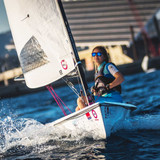
- Qty in Cart
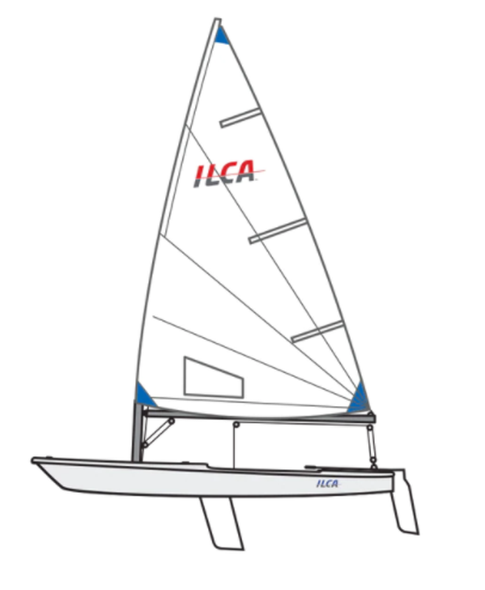
Ovington ILCA - Race

Zim ILCA - Club

RS Venture Connect

- Total: items /
- Add all to cart

Adding your products to cart
Subscribe to our newsletter.
Sign up for our newsletter to receive exclusive discounts, new product announcements, and upcoming sales.

Can One Person Sail a Catamaran? (Complete Guide)
Posted on June 1, 2022
Sailing with friends and family members, even strangers at times, can be so exciting. However, there is nothing that gives us peace of mind like sailing off on our catamaran along the coast or even into the deep blue, alone. Another plus is being able to sail alone while other crew members sleep or rest.
Bear in mind, that this is not a trip for the faint of heart or inexperienced sailor, when going solo. You have to get a boat designed for solo sailing, or things could go awry quickly. Catamarans are recognized for their comfort and stability, but is it possible to sail a catamaran with just one person?
Many contemporary catamarans are made for solo sailing, meaning only an individual at the helm station, with several exceptions. It’s always better though, if you plan to go long distances, to have at least one person traveling with you for help if or when needed .
Keep reading to discover more about sailing solo on a catamaran, its advantages, and drawbacks.

Can One Person Sail a Catamaran?
As we said earlier, yea, you can sail a catamaran alone, but not every cat is made for that purpose. Also, not every sailing condition is ideal for sailing solo. Let’s look first at when it’s ideal for one person to sail a cat.
When It’s Beneficial To Sail Solo
You can handle the Genoa or lift and lower the mainsail all from the helm station on newer Catamarans.
The autopilot on many of these bigger boats is a huge time-saver. At times when a helmsman needs to step away from the controls for a short period, the autopilot will keep the vessel on track.
Solo sailing makes it possible for the rest of the crew to sleep or relax while one sailor is keeping watch. According to my research, most crews on sailing catamarans choose two to four-hour watch periods, even though there’s not a specific period of limitation for being on watch.

Is Previous Sailing Experience Necessary for Solo Sailing?
How much training does the helmsman need before he or she can sail alone? Everything from the vessel itself to its captain and navigator to the weather and other potential sailing risks all plays a part.
Inexperienced sailors need a second set of eyes and ears to help guide them through the process of making and implementing decisions.
Reefing, changing courses, or just staying with the captain to boost his confidence are all things that benefit from having two sets of eyes.
It Is Difficult To Sail A Catamaran Alone?

One of the biggest challenges in sailing a catamaran is navigating the boat’s shape. Because of their wide stance, catamarans are difficult to maneuver in small spaces. Thrusters on some catamarans assist alleviate these issues.
It’s also more difficult to operate a catamaran than a single-hulled vessel. If you’re flying a closed-cockpit aircraft, it’s not always easy to reach the boom. However, the catamaran’s pros far outweigh its cons.
Because you can’t dive into the cockpit from the deck like you can on a monohull when the boat needs to be maneuvered rapidly, singlehanded sailing is challenging. Catamarans, on the other hand, have a lot of interior space.
Buying a large, expensive boat with 90% of the interior space unused may not be an issue. However, it makes you wonder why you even buy one that big to sail alone?
Weather Conditions for Solo Sailing

Is it possible for you to sail alone in any weather conditions? If you’re planning to cruise alone, you may want to reconsider. Sailing alone during terrible weather or a storm may not be a good idea unless it can’t be avoided.
It may seem obvious, but it’s preferable to let another member of the crew know if you’re going to need to make a rapid move so they can be prepared. Yes, a sudden shift in wind direction or speed can cause damage to the sails or even cause the boat to capsize.
It’s always a good idea to have a second person on standby in the event of an emergency, even if the situation can be handled by one person.
What Size Catamaran Is Best For Solo Sailing?

In contrast to monohulls, catamaran sizes are far more varied. Catamarans come in two primary varieties: open and cruising.
Open catamarans are too small for long-distance cruising. Only a tiny number of people are interested in purchasing these boats for racing or recreational purposes. The majority of open catamarans are designed to be sailed by a single person even though some can accommodate two or more crew members.
Catamarans are completely different beasts. Between 30 and 50 feet is the length of these vessels that you’ll find available. Catamarans that are more than 60 feet long are considered superyachts. No luxury catamaran can be sailed without the aid of complex electromechanical and automated equipment.
A 35- to 45-foot cruising catamaran is a good length to aim for when building your own. Due to the small amount of force required to modify halyards as well as reef the sail, these sizes are practicable for most sailors to use.
When traveling in a smaller catamaran, the view from the helmsman’s seat is usually sufficient to avoid needing additional spotters. On these vessels, getting to the sails and winches takes less time since you will never have to sprint 20 feet from the cockpit to the mast or vice versa.
Are Catamarans Usually Bought for Solo Handling?
Catamarans aren’t typically purchased by individuals for the sole purpose of solo sailing. As a result of their double hulls, catamaran boats are far more common with families and for hosting parties. Single-person catamarans are rare because of this.
Catamarans of this type have been around for a long time. A single crew member was typically onboard, although these vessels were constructed to set a new record for extreme adventure. These types of catamarans only exist in fiction; they are not commercially available.
Catamaran Solo Traveler Guide

It’s vital to learn and rehearse your skills. Because you will be sailing alone, you must become fluent in both basic and advanced boating skills. Moves like going forward or backward or turning must be practiced.
There will be no one to criticize for any mishaps, since there will be no one else on board to blame. Ideally, you should practice and then master each skill set.
Inspect the Catamaran
You need to do this. It’s a good idea to hire a boat assessment expert when you’re not aware of the process. Take care to inspect your boat thoroughly to ensure it is free of problems and imperfections. To sail in practically any condition, make sure the boat is in fantastic form for sailing.
Check the Weather
Don’t go sailing if it’s going to be windy. For boating, sunny and clear days are ideal. When traveling across open water, even a small storm might be hazardous. It’s important to verify the forecasts before planning a boating trip.
It is recommended that you Install Automatic Winches
With automatic winches, single-handed sailing may still be a piece of cake. To raise and lower the sail, all you have to do is step out on the deck and manage the lines as well as sheets from the cockpit.
Since you will not have to expend yourself by pulling on the rope with an automatic winch, you save energy as well. With automatic winches, tacks can be made on the headsail without the need to climb up the deck.
Advanced automatic controls can be added to your autopilot system if you so desire. Using meteorological data from equipment, the system can drive your catamaran rather than you and adjust the sails for maximum speed and efficiency.
Be a Minimalist
If you’re a solo sailor, you can forget to pack the most essential items . Freshwater, food, gasoline, knives, life jackets, knives, gasoline, food, batteries, light sources, and fishing rods, are all required. Calculate the length of your journey and pack extra food and water.
Take Mitigation Measures

There is a general disrespect for safety protocols and crises by the majority of people, typically young sailors.
Preparedness is essential since emergencies don’t arrive at your door. You should have a first aid kit on hand, as well as some useful info regarding what to do in specific situations.
A radar alert system should be installed as well. This can have a significant impact on the safety of the trip. In addition to alerting you to nearby ships, like cargo ships, these devices also supply you with facts about the boat’s speed and size.
Always think about the worst-case scenario and prepare for it. In a pinch, that’s the best strategy for keeping your mind from going blank.
Is Sailing a Catamaran Alone a Good Idea?
To summarize, solo catamaran sailing has proven to be a worthwhile experience for me. You require staff on board at all times, notably in a few of the conditions described above, even though most modern Catamarans are meant to be operated by a single person.
People with and without prior sailing expertise can all enjoy the benefits of cruising and exploring aboard modern sailing catamarans.
No products in the cart.
Sailing Ellidah is supported by our readers. Buying through our links may earn us an affiliate commission at no extra cost to you.
The Largest Sailboat You Should Get For Your Solo Adventure
I still remember the day like it was yesterday when I asked myself: “How big of a sailboat can one person handle?” I had absolutely no idea and didn’t even know how to sail back then. Many years later, I’ve got the experience and knowledge to answer this question for you in detail.
A beginner should stay below 40 feet until they get some experience. With moderate experience, one person can comfortably handle a 45-foot sailboat. To exceed 45 feet, you want to have a high level of experience and a boat with systems to assist you in handling your sails and equipment.
As with everything else related to sailing, the ability to handle a sailboat depends significantly on your sailing experience, physical fitness, and how the boat you want to sail is set up.
Determining the size of sailboat you can handle depending on experience and sailing systems
There is a massive variety of sailboats; many are well suited for single or short-handed sailing, while others require a crew to be sailed safely. One thing to also keep in mind is that even when sailing as a couple, you’ll be in situations where only one of you will be available to handle the sailboat.
Especially if you plan on doing extended sailing with frequent overnight passages. There may be situations where your better (or worse) half is sick or unable to help in a tense situation, and you’re on your own to handle the boat. So please do yourself a favor and be realistic with yourself and your capabilities before choosing the size of your boat.
Can you reef a massive sail by yourself in a sudden 50-knot storm in the middle of the night? Only you know the answer to that after you’ve tried it. Since we’re all different in our level of fitness and capability, I’ll keep the average person as a reference throughout this article, and you’ll have to consider where you stand in relation to this before making a choice.
Right, with the pep-talk done, let’s move on!
After chatting with several oldtimers with half a lifetime of bluewater sailing, we all came to the same conclusion. The table below shows approximately how big of a sailboat one person with good physical fitness can handle depending on configuration and experience level:
Critical elements to consider for handling a large sailboat alone
This article refers to sizes above 45 feet when discussing large sailboats. Once we get past 45 feet, we reach a point where the sail area is close to or bigger than 500 ft 2 or 45 m 2 on a modern sloop. It takes serious physical strength to handle sails of this size manually. Ketch-rigged sailboats spread the total sail area over an additional mizzen sail to allow easier sail handling of the individual sails.
Handling big sails is just one task that gets increasingly difficult on bigger boats. Your lines and equipment are more substantial in size and heavier as well. Leading all the lines back to the cockpit makes for an easier short-handed setup and keeps you in the safety of the cockpit in most situations.
Another thing worth mentioning is the price tag for buying and maintaining a large boat. The cost increases exponentially with size, so I recommend purchasing the smallest boat you are comfortable being on and the biggest you feel comfortable sailing and operating within a price range you can afford.
Most people looking to sail solo will end up with a sailboat in the 35-45-foot size range, especially if they plan to spend extended time onboard. You may be looking at smaller vessels too, but remember that you’ll sacrifice more space and speed the smaller the boat you choose.
There are many good reasons why you want to go bigger as well, and you should know that you definitely can. Just consider what can be challenging on a larger boat versus a smaller one and understand what you get yourself into.
Finding the right size range is all about the balance between what your capabilities can handle, the size of your cruising budget, and your preference for comfort and amenities onboard.
Let us have a look at some of the tasks we need to be able to handle on a sailboat alone, which might be more demanding on a larger boat.
By the way, I wrote an article about the ideal size for a liveaboard sailboat that is more relevant for those who won’t be sailing solo,
Operational tasks at sea
- Hoist, lower, furl, and reef sails in various conditions
- Trimming the sails
- Steering the boat
- Navigating in various conditions
Managing the sails can be solved in a couple of ways. If you choose a ketch, you’ll have less sail area to handle at a time at the expense of an additional mizzen sail. Many modern sloop-rigged sailboats above 45 feet have electrical winches, making hoisting, furling, and trimming sails easier. Electrical winches are usually reliable and can still be operated manually in case of failure.
Even below this size range, most modern boats have an autopilot, making it dramatically easier to handle the boat alone. A good autopilot is said to be the most valued crew member onboard, and I agree. My autopilot even has a name; Raymond is a trusted companion who hasn’t disappointed me. ( Yet, knock on wood )
The problem when relying on electric systems is that we might be in big trouble if they fail, which is an essential factor to consider and make a backup plan for. When you have years of sailing experience, you know how to handle situations well and what you can do to make things simpler for yourself.
Think about this: Can you manually reef your massive sails if the wind suddenly increases to 50 knots?
And yes, that does happen offshore.
Operational tasks going to port or mooring
- Dropping and lifting the anchor
- Maneuver the boat in and out of a marina or port
- Tie the boat to the dock or pontoon
On a 45-55 foot sailboat, you will typically have an anchor that weighs 30-45 kg or 65-100 lbs. That anchor is attached to a 10-12mm chain. If you anchored at a 10m water depth, you probably have at least 50 meters of chain out.
The weight of 12mm chain is about 3.4 kg or 7.5 lbs per meter. This means you have 170kg or 375 lbs of chain in the water plus the weight of your anchor. Pulling that weight up from the seabed is a challenging workout that makes you want to rely on your windlass. But windlasses can fail, and I speak from experience.
I have pulled my 25 kg Rocna together with 75kg of chain off the seabed a few times, and I sweat at the thought of handling anything larger. On a smaller boat, the ground tackle weighs a lot less and is more manageable for one person.
Docking a large sailboat
Maneuvering any size sailboat into port is nerve-wracking for most people their first few times. I remember being scared to death my first few times docking by myself, and I didn’t have a bow thruster to assist. You won’t be able to push or single-handedly move a sailboat above 45 foot by yourself if there is a little bit of wind.
Modern vessels of this size usually have a bow thruster, making it significantly easier to maneuver the vessel into tight areas and marinas. My friend, who has been sailing his entire life, lives aboard and sails his close to 55 foot sailboat. His boat has a bow and stern thruster, making it easier to maneuver than my 40 foot boat!
Now, most boats don’t have that luxury, and a lot of practice will be necessary for getting confident in and out of a marina. NauticEd has a course on maneuvering by engine and docking that you may want to look at here .
Conclusion: Is it realistic to sail a large sailboat by yourself?
With a decent level of experience and a well-equipped sailboat adequately set up for single-handed operation, it is absolutely possible to handle a large sailboat alone. I know several sailors who sail large vessels by themselves.
As long as you have some sailing experience and good physical fitness, are aware of your limitations, and have a decent plan in case of equipment failure, you will, in most everyday situations, be able to handle a 50 foot sailboat and possibly larger alone. If you plan on buying a large sailboat, remember to consider the factors we have looked at in this article and be realistic about your budget.
There are just as many people upgrading to a bigger boat as downgrading to a smaller one. What size sailboat is right for you comes down to your needs, experience level, and budget. Take your time to make the right decision if you want to buy a boat, and be realistic about your capabilities and experience before you take on the task of sailing a large sailboat by yourself.
Sharing is caring!
Skipper, Electrician and ROV Pilot
Robin is the founder and owner of Sailing Ellidah and has been living on his sailboat since 2019. He is currently on a journey to sail around the world and is passionate about writing his story and helpful content to inspire others who share his interest in sailing.
I am writing a novel in which knowledge of sailing and sailboats would be helpful. Would you be available to answer an occasional technical question via email? The setting is primarily the Gulf of Mexico, Lake Pontchartrain, and the Mississippi Gulf Coast, but will include time in the Bahamas and Caymans. The time is 1964-65.
Hoping to hear from you, and thanks.
Send me an email and I’ll do my best to assist you!
Leave a Reply Cancel reply
Your email address will not be published. Required fields are marked *

Builders of the Ultimate One Man Boat
Warrior One Man Boat
The ultimate one man boat - made in america, if you're looking for a one man boat, you're in the right place. if you're looking for the ultimate one man boat or the ultimate one man fishing boat, you can throw in a truck and get to the pond of your dreams, you're in the right place. if you've ever wanted to hunt or fish in an area that others can't get to, you're looking at the best one man boat for the job. hand-made, with tons of quality and spectacular design, warrior one man boats are the ultimate one man boats. lightweight, fast, sleek and sporty, these one man boats cut right through the water with virtually no sound - and they get you to that sweet spot, that honey hole where no one has been, and no one else can get to. check out the warrior one man boat online, then find a local dealer to see our incredibly well-built crafts in person., check out the 8 reasons why warrior one man boats are the ultimate one man boats, you found us, now try us out. we believe, and so do the owners of our one man boats, that our design and personalized craftsmanship is unparalleled and top of the line. continue to browse to see why, or click the dealer locator link to find the nearest dealer for warrior one man boats., tested and ready.
All Warrior One Man Boats are individually and meticulously handcrafted from a specialized hardened plastic (no rough-edge fiberglass snags). You can instantly feel the quality as you run your hand across the smooth, thick, solid surfaces. All boats are float-tested, and each weld and rivet inspected. We believe in our products. We want you to believe in them as well.
7 Models and Colors
Our seven (7) different models are all 10’ boats with various color combinations from dark brown, dark green, camo, or a combination. With fully licensed camo designs from Mossy Oak, the camouflage one man boats come with custom matching seats and matching accessory items like foot pedals, live-well covers and motor covers. All designs include our custom accessories like the quick-disconnect battery cables and built-in stainless steel motor guides.
Individually Crafted
We not only build each craft individually by hand, we inspect, float-test, and stand behind our product 100%. Our goal is to build the best one man boat in America. We want you to compare our boats with the others on the market. Don't buy another until you check these out. You will see, like we know, Warrior One Man Boats are the best one man boats made. Solid, dependable and high-quality, they're the kind of boats we would want to own. In fact, we do!
Come See Us!
We are located in South Carolina near the banks of Lake Marion, and some of the best water in the US river system, such as Black River, Pee Dee, Lynches and Santee. Our Warrior One Man Boats have been proven in the swamps of South Carolina and tested by the best outdoorsmen in the country. Check us out at a local dealer, and don't consider buying a one man boat without considering us.
Sailor Cole Brauer makes history as the first American woman to race solo around the world
Aboard her 40-foot racing boat First Light , 29-year-old Cole Brauer just became the first American woman to race nonstop around the world by herself.
The New York native pulled into A Coruña, Spain, on Thursday after a treacherous 30,000-mile journey that took 130 days.
She thanked a cheering crowd of family and fans who had been waiting for her on shore.
“This is really cool and so overwhelming in every sense of the word,” she exclaimed, before drinking Champagne from her trophy.
The 5-foot-2 powerhouse placed second out of 16 avid sailors who competed in the Global Solo Challenge, a circumnavigation race that started in A Coruña with participants from 10 countries. The first-of-its-kind event allowed a wide range of boats to set off in successive departures based on performance characteristics. Brauer started on Oct. 29, sailing down the west coast of Africa, over to Australia, and around the tip of South America before returning to Spain.
Brauer is the only woman and the youngest competitor in the event — something she hopes young girls in and out of the sport can draw inspiration from.
“It would be amazing if there was just one girl that saw me and said, ‘Oh, I can do that too,’” Brauer said of her history-making sail.
It’s a grueling race, and more than half of the competitors have dropped out so far. One struck something that caused his boat to flood, and another sailor had to abandon his ship after a mast broke as a severe storm was moving in.
The four-month journey is fraught with danger, including navigating the three “Great Capes” of Africa, Australia and South America. Rounding South America’s Cape Horn, where the Atlantic and Pacific Oceans meet, is often likened to climbing Mount Everest because of its perfect storm of hazards — a sharp rise in the ocean floor and whipping westerly winds push up massive waves. Combined with the frigid waters and stray icebergs, the area is known as a graveyard for ships, according to NASA. Brauer said she was “so unbelievably stoked” when she sailed past Cape Horn in January.
Marco Nannini, organizer of the Global Solo Challenge, said the comparison to scaling Mount Everest doesn’t capture the difficulty of the race. Sailing solo means not just being a skipper but a project manager — steering the boat, fixing equipment, understanding the weather and maintaining one’s physical health.
Nannini cited the relatively minuscule number of people who have sailed around the world solo — 186, according to the International Association of Cape Horners — as evidence of the challenges that competitors face. More than 6,000 people have climbed Mount Everest, according to High Adventure Expeditions .
Brauer stared down 30-foot waves that had enough force to throw her across the boat. In a scare caught on camera, she badly injured her rib near the halfway point of the event. At another point, her team in the U.S. directed Brauer to insert an IV into her own arm due to dehydration from vomiting and diarrhea.
She was able to stay in constant communication with members of her team, most of whom are based in New England, and keep herself entertained with Netflix and video calls with family through Starlink satellites. That’s also how Brauer was able to use Zoom to connect with NBC News for an interview, while she was sailing about 1,000 miles west of the Canary Islands.
While Brauer was technically alone on First Light, she had the company of 450,000 followers on Instagram, where she frequently got candid about life on an unforgiving sea while reflecting on her journey.
“It all makes it worth it when you come out here, you sit on the bow, and you see how beautiful it is,” she said in an Instagram video, before panning the camera to reveal the radiant sunrise.
Brauer grew up on Long Island but didn’t learn to sail until she went to college in Hawaii. She traded in her goal of becoming a doctor for life on the water. But she quickly learned making a career as a sailor is extremely difficult, with professional racers often hesitant to welcome a 100-pound young woman on their team.
Even when she was trying to find sponsors for the Global Solo Challenge, she said a lot of people “wouldn’t touch her with a 10-foot pole” because they saw her as a “liability.”
Brauer’s message to the skeptics and naysayers? “Watch me.”
“I push so much harder when someone’s like, ‘No, you can’t do that,’ or ‘You’re too small,’” Brauer explained.
“The biggest asset is your mental strength, not the physical one,” Nannini said. “Cole is showing everyone that.”
Brauer hopes to continue competing professionally and is already eyeing another around-the-world competition, but not before she gets her hands on a croissant and cappuccino.
“My mouth is watering just thinking about that.”
Emilie Ikeda is an NBC News correspondent.

One person taken to hospital after vessel crashes into Sanibel Causeway, FWC says
One person was taken to a hospital Thursday afternoon after authorities say a boat crashed into the Sanibel Causeway.
Hailee Seely, spokesperson for the Florida Fish and Wildlife Conservation Commission, said the crash happened around 3:30 p.m., when authorities received a report of a single-vessel accident near the southwest side of the Sanibel Causeway.
The FWC, the Lee County Sheriff’s Office, the U.S. Coast Guard and Lee County EMS responded to a 24-foot vessel that collided with the rocks near the bridge, Seely said.
The vessel's sole occupant is being treated for their injuries. The extent of the injuries remained unknown Thursday evening.
Kayla Rincon-Miller murder: Cape Coral police arrest North Fort Myers teen linked to Sunday slaying of girl, 15
Nicole Groll, spokesperson for the U.S. Coast Guard, said initial reports indicated two boaters crashed their vessel into a jetty, but later learned it was only the one boater, who was with EMS.
The crash comes less than a week after a boat crashed in North Naples , killing two.
Tomas Rodriguez is a Breaking/Live News Reporter for the Naples Daily News and The News-Press. You can reach Tomas at [email protected] or 772-333-5501. Connect with him on Threads @tomasfrobeltran , Instagram @tomasfrobeltran and Facebook @tomasrodrigueznews .
This article originally appeared on Naples Daily News: One person taken to hospital after vessel crashes into Sanibel Causeway, FWC says
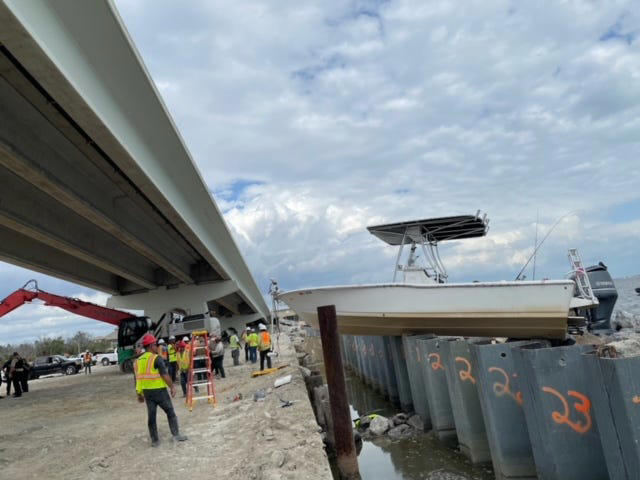
Boat Boat Go
Love Boat Party Life
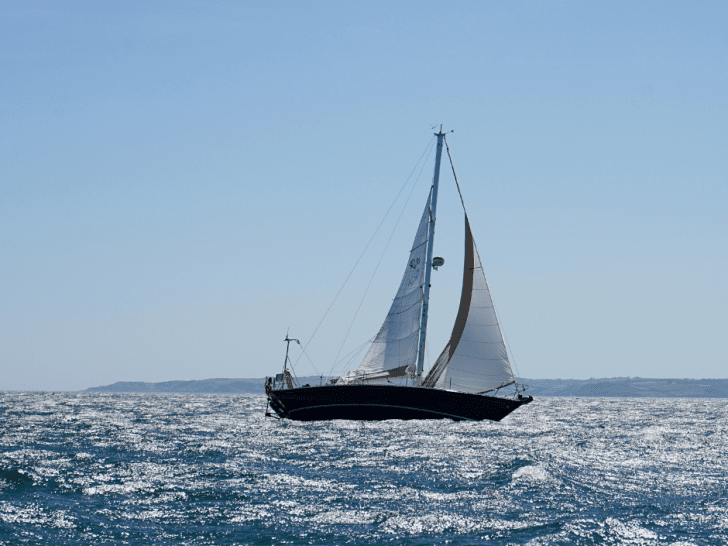
One Person Sailboat Sailing: Tips for Safe and Efficient Navigation
Sailing alone in a sailboat can be an exhilarating and rewarding experience. However, it can also be challenging, especially for those who are new to the sport. Whether you’re a seasoned sailor or a beginner, it’s important to follow certain tips to ensure safe and efficient navigation.
Table of Contents
Understanding the Basics of One Person Sailboat Sailing
Sailing a sailboat alone can be a thrilling and rewarding experience. However, it requires a good understanding of the basics of sailing to do it safely and efficiently. In this section, we will discuss the essential aspects of one person sailboat sailing.
Choosing the Right Sailboat
Choosing the right sailboat is crucial for one person sailing. It should be easy to handle and maneuver, and the rigging should be simple enough to manage alone. Some sailboats are specifically designed for single-handed sailing, while others may require some modifications to make them suitable.
A few examples of sailboats that are suitable for one person sailing are:
Weather and Sea Conditions
Understanding weather and sea conditions is essential for safe sailing. Before setting out, it is essential to check the weather forecast and sea conditions. It is best to avoid sailing in strong winds, high waves, or thunderstorms.
Here are some tips for sailing in different wind directions:
- Upwind Sailing: This includes two points of sail called close reaching and close-hauled. This is when you sail towards the path of the wind. Close-hauled is as close to the wind as you can get, just off the No-Go Zone. Your sails will have to be trimmed tightly for this to work.
- Downwind Sailing: This includes two points of sail called running and broad reaching. Running is when the wind is behind you and the sails are let out all the way. Broad reaching is when the wind is coming from behind the boat, but not directly behind you. The sails are let out slightly less than when running.
- Reaching Sailing: This is when the wind is coming from the side of the boat. There are two types of reaching: beam reaching and broad reaching. Beam reaching is when the wind is coming from the side of the boat at a 90-degree angle. Broad reaching is when the wind is coming from the side of the boat at an angle that is less than 90 degrees.
Preparation Before Sailing
Before setting sail on a one-person sailboat, it is crucial to ensure that all necessary preparations have been made. This section will cover two important sub-sections: Checking Equipment and Planning the Route.
Checking Equipment
Checking the equipment before setting sail is essential to ensure a safe and enjoyable sailing experience. Here are some equipment checks that should be performed:
- Personal flotation device (PFD): Make sure that the PFD is in good condition and fits properly.
- Sails: Check the condition of the sails and ensure that they are rigged correctly.
- Lines and rigging: Check all lines and rigging for any signs of wear or damage.
- Navigation equipment: Ensure that all navigation equipment is in good working condition, including the compass, GPS, and charts.
- Emergency equipment: Check that all emergency equipment, such as flares, VHF radio, and first aid kit, are on board and in good condition.
By checking the equipment before setting sail, the sailor can ensure that they are prepared for any situation that may arise while on the water.
Planning the Route
Planning the route is another crucial step in preparing for a safe and efficient sailing experience. Here are some factors to consider when planning the route:
- Weather conditions: Check the weather forecast and plan the route accordingly. Avoid sailing in strong winds or rough seas.
- Tide and current: Take into account the tide and current when planning the route. Sailing with the tide and current can help save time and energy.
- Navigation hazards: Identify any navigation hazards, such as rocks, shoals, or other vessels, and plan the route to avoid them.
- Distance and time: Consider the distance and time required to complete the route. Ensure that there is enough time to complete the route safely and efficiently.
Navigational Skills for Sailing
Sailing is an exciting and rewarding activity that requires a certain level of navigational skills to ensure safe and efficient navigation. In this section, we will discuss two important navigational skills for sailing: Using Nautical Charts and Understanding Compass and GPS.
Using Nautical Charts
Nautical charts are essential tools for navigation when sailing. They provide valuable information about water depths, underwater obstructions, and shoreline features. Here are some tips for using nautical charts effectively:
- Always keep the chart up-to-date by obtaining the latest edition and correcting it with the Notices to Mariners.
- Use parallel rulers and dividers to plot a course and measure distances accurately.
- Identify landmarks, buoys, and other navigational aids to help you navigate.
- Use caution when navigating in areas with shoals, rocks, or other hazards. Consult the chart for information on water depths and potential obstructions.
Understanding Compass and GPS
Compass and GPS are two important tools for navigation when sailing. They provide valuable information about direction, speed, and location. Here are some tips for understanding compass and GPS:
- Always keep the compass away from metal objects, electronics, and other sources of interference.
- Use the compass to determine your direction and make course corrections as needed.
- Use GPS to determine your location, speed, and course. Set waypoints to help you navigate and avoid potential hazards.
- Use caution when navigating in areas with poor GPS signal or interference. Consult the chart and other navigational aids to confirm your location and course.
Safety Measures for Single-Handed Sailing
Sailing alone can be a thrilling and rewarding experience, but it also comes with its own set of risks. To ensure a safe and enjoyable journey, it is essential to take the necessary safety measures. This section provides some tips on how to stay safe while sailing solo.
Personal Safety Equipment
Wearing the right safety gear is crucial when sailing alone. The following are some essential personal safety equipment that every solo sailor should have on board:
- Lifejacket : A lifejacket is a must-have safety gear for any sailor, especially when sailing alone. It can keep you afloat in case you fall overboard or encounter any other emergency situation.
- Harness and Tether : A harness and tether are used to keep you attached to the boat at all times. It can prevent you from falling overboard and help you stay safe in rough weather conditions.
- Emergency Position Indicating Radio Beacon (EPIRB) : An EPIRB is a device that sends a distress signal to rescue services in case of an emergency. It can help rescuers locate you quickly and save your life.
Emergency Procedures
Sailing alone means that there is no one else to rely on in case of an emergency. Therefore, it is essential to have a plan in place to deal with any unexpected situations. The following are some emergency procedures that every solo sailor should be familiar with:
- Man Overboard : Falling overboard is one of the most common accidents that can happen when sailing solo. The first step to take in such a situation is to stop the boat and mark the position where the person fell overboard. Then, try to retrieve the person using a life ring or any other rescue equipment.
- Fire : A fire on board can be catastrophic, especially when sailing alone. The best way to prevent a fire is to have a fire extinguisher on board and to be familiar with how to use it. In case of a fire, it is essential to extinguish it as soon as possible and call for help.
- Collision : Collisions with other boats, rocks, or other obstacles can cause severe damage to your boat and put your life at risk. In case of a collision, it is essential to assess the damage and take appropriate measures to prevent further damage.
Efficient Sailing Techniques
Mastering sail trim.
One of the most important aspects of efficient sailing is mastering sail trim. Proper sail trim can help the sailboat move faster and more efficiently through the water. The first step in mastering sail trim is to understand the different parts of the sail. The mainsail is the large sail that is attached to the mast and boom, while the headsail is the smaller sail that is attached to the forestay.
To achieve proper sail trim, the sailor should adjust the sails to the wind direction and speed. The mainsail should be trimmed so that it is parallel to the centerline of the boat, and the headsail should be trimmed so that it is parallel to the wind. If the wind speed increases, the sailor should ease the sails to prevent the boat from heeling over too much. On the other hand, if the wind speed decreases, the sailor should tighten the sails to maintain speed.
Balancing the Boat
Another important aspect of efficient sailing is balancing the boat. The sailor should aim to keep the boat level at all times to reduce drag and increase speed. To achieve this, the sailor should adjust the sails and weight distribution of the boat.
If the boat is heeling too much to one side, the sailor should adjust the sails to reduce the pressure on that side. The sailor can also move weight to the opposite side of the boat to help balance it. For example, if the boat is heeling to the port side, the sailor can move weight to the starboard side to help balance it.
In addition, the sailor should be aware of the boat’s center of gravity. The center of gravity should be kept low to reduce heeling and increase stability. This can be achieved by moving heavy objects, such as water tanks or anchors, to the bottom of the boat.
Maintenance Tips for Sailboat
Sailing a one-person sailboat can be a thrilling experience, but it also requires proper maintenance to ensure safe and efficient navigation. Here are some maintenance tips for sailboat that every sailor should follow:
Regular Inspection
Regular inspection of the sailboat is a crucial step in ensuring its smooth functioning. Here are some key areas to inspect:
- Sails: Check the sails for any signs of wear and tear. Look for holes, rips, and loose stitching. Repair or replace damaged sails as soon as possible.
- Rigging: Inspect the rigging for any signs of corrosion, cracks, or bends. Check the turnbuckles and clevis pins for tightness and wear. Replace any worn-out or damaged parts.
- Hull: Check the hull for any cracks, dents, or scratches. Look for any signs of water intrusion or soft spots. Repair any damage to the hull as soon as possible.
- Electrical System: Inspect the electrical system for any signs of corrosion, loose connections, or damaged wires. Check the battery for proper voltage and charge. Replace any worn-out or damaged parts.
Cleaning and Storage
Proper cleaning and storage of the sailboat can extend its life and prevent damage. Here are some tips:
- Cleaning: Clean the sailboat after every use. Use a mild soap and water solution to wash the deck, hull, and rigging. Rinse with fresh water and dry the sailboat thoroughly. Apply a coat of wax to protect the hull from UV rays and saltwater.
- Storage: Store the sailboat in a dry and secure location. Cover the sailboat with a tarp to protect it from the elements. Remove the sails and store them in a cool and dry place. Disconnect the battery and store it in a cool and dry place.
In conclusion, sailing a one-person sailboat can be a thrilling and rewarding experience. However, it requires proper navigation skills and safety measures to ensure a safe and efficient journey.
Related posts:
- How Fast Can A Boat Go Depending On Horsepower?
- How Far Can You Transmit with a 25 Watt VHF Radio? Explained
- Why Height Matters: Importance and Benefits of a VHF Radio Antenna
- The Legalities of Bringing Your Dog on a Boat: Understanding Local Regulations
Terms and Conditions - Privacy Policy
- Link copied! Clipboard
Watch: The moments after a boat crashes along the Sanibel Causeway
According to the Florida Fish and Wildlife Conservation Commission, the vessel’s sole occupant, Isreal Rogner of Punta Gorda, was transported to the hospital and is being treated for injuries.
LCSO Marine Unit is on scene of a boat crash at the Sanibel Causeway. FWC is the lead investigative agency. pic.twitter.com/46O1U9e3FV window.zone_load_1206482514 = function(z, d) { if (!d.count) document.getElementById('zone_load_1206482514').style.display = 'none'; }; — Carmine Marceno – Florida’s Law and Order Sheriff (@SheriffLeeFL) March 21, 2024

Can One Person Sail a Ketch?

Last Updated by
Jacob Collier
August 30, 2022
If you want to test your endurance and perform feats of adventure, sailing on a ketch single handedly is a great idea. But can one person sail a ketch?
A ketch has two masts and a sail area divided into multiple sails, which means it’s easier to manage and is a great vessel for single-handed sailing. This rig offers more versatility and it can handle heavy winds well, which is why it is quite popular.
The ketch is a very effective and advantageous rig for bigger vessels that have a size of 40ft or more. However, before you decide to go on a solo cruise on it, it is important that you understand the factors at play when sailing a ketch.
As a person who has been sailing solo for over 20 years, I can guide on what single-handedly sailing a ketch is like based on my own experiences. This way, you can figure out whether solo ketch sailing is for you or not.
Table of contents
What is a Ketch?
A ketch is a two-masted sailboat that has a large mainmast and a shorter mizzenmast. Both of these masts have a mainsail. The mizzenmast is very useful for solo sailing and I have put it to all sorts of creative uses to sail my ketch.
Overall, a ketch is widely recognized as one of the best types of sailboats for long-distance solo cruising. There are many reasons why that is so and we will go through them one by one below. However, some of its biggest reasons are that it is incredibly comfortable to handle, operate, maneuver, and ride in. This increased comfort is due to the extra mizzen sail which offers an improved power balance.
What Kind of People Can Ride a Ketch?
The ketch is a particularly great sailboat for long distance cruising, particularly if you are expecting rough waters and heavy winds and are short-handed. Hence it is a great vessel for solo adventurers, couples who want to sail the world together, and even a liveaboard family, since you can sail a larger boat without needing extra crew members to handle the craft.
Why is a Ketch an Excellent Rig for Solo Sailing?
As we mentioned above, the extra mast of the ketch is what makes sailing it so easy, even if you are just one person. Let us take a look at what benefits a ketch offers a lone sailor.
Perform Well in Downwind Conditions
Most modern sailboats use the Bermuda rig or the Marconi rig which have the mainsail and jib sail that get in each other’s way in downwind conditions. The ketch’s sail configuration results in fewer such problems, however. The mainsail and the mizzensail work seamlessly and efficiently together, except when sailing very close to the wind. Even then, the Bermuda rig and the ketch rig can go neck and neck in such conditions. In fact, unless you are a racer, a ketch is an excellent alternative to the Bermuda rig.
Have Easily-Manageable Smaller Sails
The ketch is an excellent single-handed rig, particularly if you are manning a large vessel with a size 40 feet and above. Using smaller but a larger number of sails allow you to have a bigger sail area, but one which can still be managed by a single person.
In addition, smaller sails are easy to handle during heavier winds.Splitting the sail area allows you greater control of the ketch, even if it is a skeleton crew or just one person.
Multiple Sails Offer More Control
Because of the two masts, the ketch rig can accommodate three primary sails instead of only two. The greater number of sails offers all kinds of benefits, which we will discuss later on the guide; however, the most important one is that it offers you more control. The mizzensail also results in improved control over the stern.
In addition, you also get a lot of different trimming options for all sailing control, allowing you better control of each point of sail and in any wind condition.
Have Versatile Sail Plans
The extra sail offers you a variety of sail plan options. Sailors have the benefit of a broader operating range. In case of light winds, you have the option of putting up more sails. In rougher winds, however, you will need to take down more sails as well.
You can reef in various versatile conditions and even take down the mainsail if you want to.
Have An Extra Sail
This extra sail offers a huge number of benefits for sole sailors. For example, if your mainsail is in need of maintenance, you can just take it down without even needing to stop — the mizzensail will allow you control of the stern and will maintain your speed.
The ketch can sail on all points of wind, whether its main is down, mizzen is down, or jib is down. A spare sail can come in handy in a lot of wind conditions.
Deliver More Balanced Sailing
Ketches offers several upsides that you do not get with the modern Bermuda sloop vessel. It's mizzensail balances the jib. This means you can leave the mainsail down without it affecting the control and speed of the boat.
I have found this type of sail plan to be very balanced and it has allowed me to self-steer on a temporary basis, if somehow the autopilot on your boat breaks down temporarily.
Excellent Sail Plan in Rough Winds
Due to its more balanced sail plans, ketches offer a more comfortable ride in heavy winds, which is why many sailors prefer to take it out in rough weather. By taking down the mainsail and sailing with just the mizzensail and the jib, a ketch instantly becomes storm-ready while offering a lot of control than even replacing the mainsail with the single stormsail on a Bermuda offering.
Less Rigging Stress
When you reduce the size of the sails, you do not put as much stress on the rigging as larger sails do. In addition, it also gives you the option of using shorter masts, making them more stable and stronger. The difference in mast length is not that big; however, the forces acting on the mast are directly proportional to its length and grow exponentially the larger the mast is. So a slightly shorter mast can make a big difference.
This also reduces the stress of the rigging, which can lead to less wear and tear and lower maintenance costs. This is a big upside when compared to the Bermuda rig since it experiences more stress on the rigging.
Mizzenmast As An Air Rudder
The mizzenmast can be extremely helpful when it comes to mooring and other types of navigation. Many people who operate ketches use the mizzenmast as a type of wind rudder, which can be very useful when you want to sail with extra control. If you learn to use the mizzenmast well, it means you have an extra rudder, which allows you superior control over the stern and can help you maneuver your rig in tight spaces.
Riding Sail at Anchor
Another use for the mizzensail is that it can be used as a riding sail at anchor. However, I do not highly recommend that you do this often since your sail will wear down much more quickly because of higher exposure to the UV rays. I just wanted you to know that it can be done in case of emergencies when you want to keep your boat’s bow into the wind.
More Comfort But Less Speed
As you can see, there are lots of reasons why a ketch is a winner if you are sailing out alone in heavier winds. If you prioritize comfort while sailing, the mizzensail offers a lot of benefits, including improved balance as well as a variety of sail trimming options that give you a smooth ride in most sailing conditions.
However, all of this comes with the small price of slightly slower speed. The ketch is a slower vessel than a Bermuda rig. However, when sailing downwind, the ketch will more than satisfy you as its larger sail area will give it a great momentum, comparable to a Bermuda rig.
Very Fast in Right Conditions
The ketch may be a bit slower overall as compared to a Marconi rig. However, when sailing under the right conditions, it too can become incredibly fast, particularly if it is a large boat that has a well-balanced sail plan.
If you are able to use the larger sail area well and find an optimal point of sail, the ketch can go really, really fast.
Offers Easy Reefing
Because there are more sails, most of which are smaller, you can have an easier time reefing. There is less stress on the sails and it allows you to reef down in phases, one sail after the other. This results in comfortable reefing without your ketch losing too much speed.
Another thing that I have experience with is that you can also quickly drop your mainsail in heavier winds, which can instantly make you storm-proof, without disrupting your course and reducing your momentum.
So these are the reasons why a ketch is a great vessel for people who want to travel solo but also want to be prepared for all sorts of weather. Now let us take a look at some of the limitations and considerations you need to factor in to find out whether a ketch should be your preferred vessel.
Things to Consider When Sailing a Ketch Single-Handedly
Keep in mind that no matter how smooth your sailing, you will be just one person manning the ketch. Here are some things that you need to expect and prepare for when going out on a solo adventure on a ketch.
Cockpit Layout
If you are just one person sailing a ketch, the layout of the ketch is doubly important. Since you will need to do most of the navigation from the helm, it is important that your vessel has a chartplotter on deck which can make this easier. Particularly, when you are out in coastal waters, you will need to keep a proper lookout, which means less amount of time down below at the chart table.
It is important that you know your ketch well enough to operate. It is a good idea to take a refresher course on the key components of your main system before you set sail.
An autopilot can give you much needed rest if you are sailing a ketch single handedly. The autopilot is great under power as it will enable the engine to keep the batteries topped up. However, if you have not trimmed correctly for the neutral helm under sail, the autopilot will draw much more power as it needs to work hard and can quickly drain your batteries.
For this reason, it is important that you get a visible battery monitor on deck. Some autopilots also use a remote control device that you can wear that can help you alter course.
Physical Fitness
Single-handedly operating a ketch — or any boat for that matter — requires a certain level of physical fitness. Keep in mind that you will need to perform every maneuver alone for which you need energy. In addition, every maneuver will take longer and will be more arduous on a solo sail, so you want high endurance.
It can also be very easy to become dehydrated when sailing so keep a bottle of water with you and a few dry foods, like crackers to keep your energy levels up.
If you are feeling tired when you start to sail, it may trigger seasickness in you. So it is a good idea to take it easy at the start of your journey. Go only a short distance and anchor up for some hours to get some rest until you get your sea legs. These small things can make a huge difference between a wonderful solo journey on a ketch and a terrible one.
It is a good idea to get in the habit of working out a few months before you decide to sail a ketch single-handedly.
Solo Safety
It is important to take a cautious approach when sailing alone, because you will be the sole person responsible for your safety. Make sure you have everything you need at hand. It can be easy for rope and rigging to pile up when there is no other pair of hands to help you. Make sure you keep your boat tidy so that you don’t end up tangling in them, tripping, and injuring yourself — or worse going overboard.
If you do go overboard, it can become even more serious since there will be no one to help you out of the water. That is why it is important to always wear a life jacket that can help you float. It is also a good idea to wear a tether that will keep you connected to a boat. To get back onboard, you should also hang a safety ladder on the side.
Although these are simple considerations, they can make a big impact on your solo sailing journey. I hope this guide helped provide some insight to help you make the final decision of whether a ketch is a good option for you. With proper understanding of your vessel and equipment, single-handedly sailing a ketch can be a very interesting experience for people who want to explore the waters with only themselves for company.
Related Articles
What Size Sailboat Can One Person Handle?
Born into a family of sailing enthusiasts, words like “ballast” and “jibing” were often a part of dinner conversations. These days Jacob sails a Hallberg-Rassy 44, having covered almost 6000 NM. While he’s made several voyages, his favorite one is the trip from California to Hawaii as it was his first fully independent voyage.
by this author
How to Sail
Most Recent

What Does "Sailing By The Lee" Mean?
Daniel Wade
October 3, 2023

The Best Sailing Schools And Programs: Reviews & Ratings
September 26, 2023
Important Legal Info
Lifeofsailing.com is a participant in the Amazon Services LLC Associates Program, an affiliate advertising program designed to provide a means for sites to earn advertising fees by advertising and linking to Amazon. This site also participates in other affiliate programs and is compensated for referring traffic and business to these companies.
Similar Posts

How To Choose The Right Sailing Instructor
August 16, 2023

How To Sail From California To Tahiti
July 4, 2023

How To Tow A Skier Behind A Boat
May 24, 2023
Popular Posts

Best Liveaboard Catamaran Sailboats
December 28, 2023

Can a Novice Sail Around the World?
Elizabeth O'Malley
June 15, 2022

4 Best Electric Outboard Motors

How Long Did It Take The Vikings To Sail To England?

10 Best Sailboat Brands (And Why)
December 20, 2023

7 Best Places To Liveaboard A Sailboat
Get the best sailing content.
Top Rated Posts
Lifeofsailing.com is a participant in the Amazon Services LLC Associates Program, an affiliate advertising program designed to provide a means for sites to earn advertising fees by advertising and linking to Amazon. This site also participates in other affiliate programs and is compensated for referring traffic and business to these companies. (866) 342-SAIL
© 2024 Life of Sailing Email: [email protected] Address: 11816 Inwood Rd #3024 Dallas, TX 75244 Disclaimer Privacy Policy
- WEATHER ALERT Flood Warning Full Story
- WEATHER ALERT Coastal Flood Watch Full Story
- fatal crash
1 dead after 3-car crash in Voorhees, New Jersey
Officers say the Honda driver was later pronounced dead at the scene.

VOORHEES, New Jersey (WPVI) -- One person is dead after a three-car crash in Camden County on Friday night.
Officers were called to Haddonfield-Berlin Road near Lafayette Avenue in Voorhees, New Jersey just after 10 p.m.
Investigators say a 2008 Honda operated by a 21-year-old from Berlin, New Jersey, was traveling down Haddonfield-Berlin Road at a high rate of speed when it struck a 2024 Lexus SUV, which was being driven by a 53-year-old from Atco.
After striking the Lexus, the Honda crossed the double-yellow lines and hit a 2016 Chevy Traverse, according to police.
The Chevy was being driven by a 41-year-old from Voorhees.
Officers say the Honda driver was later pronounced dead at the scene. There is no word yet on the driver's identity.
The Lexus driver did not report any injuries from the crash and the Chevy driver was taken to a nearby hospital in stable condition.
Voorhees Police and the Camden County Prosecutors Office are investigating the crash. Anyone with information related to this crash should call Voorhees police at 856-428-5400.
Related Topics
- CAMDEN COUNTY
- FATAL CRASH
- INVESTIGATION
Fatal Crash

44 pre-K students on bus during deadly crash in Austin, Texas: DPS

Mitch McConnell's sister-in-law drunk drove into pond, police say

Shipping industry CEO died on Central Texas ranch, report says

Man indicted for Atlantic City boat crash that left swimmer dead
Top stories.

Emergency crews search for child swept away into Delaware County creek
- 5 minutes ago

1 dead, another hospitalized after double shooting

Heavy rain causes some flooding across Montgomery, Delaware counties

Man electrocuted, killed on Philadelphia golf course: Police

NJ hospital hosts bedside wedding ceremony so grandma doesn't miss out
$50K reward offered for info on Philly man gunned down 3 years ago
Mayor's Masked Ball in Philly raises money for students' education
2 squatters taken into custody in Pa. after body found in duffel bag

IMAGES
VIDEO
COMMENTS
In this article, I talk about single-handed sailing and look at the nine best sailboats for one person, ranging from small lake dinghies all the way to comfy cruisers capable of oceanic crossings. Here are the best sailboats for solo sailing. RS Aero. Jeanneau Sunfast 3200. Beneteau Oceanis 62.
Introduced in 2003, the Hanse 371 is a mid-sized boat that was designed in a true blend of old and new boating technology. Thanks to its furling and self- tacking jib, the Hanse 371 becomes an instant single-handed sailing vessel that takes much of the strain out of your solo sailing adventures.
The Hunter Channel 31, J/109, and West Wight Potter 19 are great budget-friendly, single-handed sailboats. Moving up in price, you can look at Hanse 371, Jeanneau Sunfast 3200, and even a Dehler 29. Depending on the size and the amount of features it has will determine what they are worth.
Catalina 16.5. jlodrummer. Catalina Yachts are synonymous with bigger boats but they have some great and smaller boats too such as Catalina 16.5. This is one of the best small sailboats that are ideal for family outings given that it has a big and roomy cockpit, as well as a large storage locker.
Hallberg Rassy 352. This is a sturdy and high-quality sailboat built between 1978 to 1991. It features a progressive design, combining a walk through with the aft-cabin from the main saloon. It is made with a tall and standard rig each supported on double and single spreaders, respectively.
It was one of the company's most successful designs . The O'Day 25 is a small recreational keelboat, built predominantly of fiberglass, with wood trim. It has a masthead sloop rig, a transom-hung rudder, and a fixed fin keel or centerboard. It displaces 4,007 lbs and has a draft of 4.25 ft. What Size Sailboat Can One Person Handle?
The 17-foot-4-inch Sun Cat, built by Com-Pac Yachts, updates the classic wooden cat with its fiberglass hull and deck and the easy-to-step Mastender Rigging System, which incorporates a hinged tabernacle to make stepping the mast a one-person job. If you want a personal sailboat ideal for solo sailing, the Sun Can is a great choice.
There are many boats that perform particularly well for shorthanded sailing. However, the fact is that the structures on a boat have a greater effect on its suitability rather than the boat's construction. Main features regarding single-handed sailing include easy sail controls, including the ability for one person to quickly tuck a reef in.
Some popular catamarans for one person sailing include the Hobie Wave, Nacra 15, and the A-Class Catamaran. These boats are designed to be fast and stable, making them perfect for solo sailing adventures. Key Features to Consider in a One Person Sailboat. When choosing a one person sailboat, there are several key features to consider.
You can learn to sail on any sailboat but small boats are better teachers because they react quickly to crew weight shifts, wind shifts and every command on the tiller or wheel. This immediate feedback is a valuable tool for student sailors and it's usually easy to spot sailors who started out on smaller tiller-driven boats rather than on large steering wheel boats because they're more ...
A 40-foot sailboat is the maximum size for one person to be able to single-handedly control safely. It can be successfully argued up or down a couple of feet, based on the experience and abilities of the sailor. This has been proven by a great many accomplished people.
The Laser Standard is a popular choice for solo sailors, thanks to its simplicity and ease of handling. This small, one-person sailboat is designed for racing, but can also be used for recreational sailing. The Laser Standard is known for its speed and agility, and is a great choice for sailors who want to experience the thrill of solo sailing.
One of the most important factors to consider when choosing a one person sailboat is the size of the boat. Generally, one person sailboats range from 10 to 30 feet in length. Smaller boats are easier to maneuver and handle, while larger boats provide more space and stability. Rigging. The rigging of a sailboat refers to the system of ropes ...
The most popular single handed one-design sailboat of all time. The ILCA is the most popular single handed one-design sailboat of all time, and has introduced countless people to the sport of sailing with over 220,000 boats delivered since inception... Qty in Cart: 0. Price: $8,105.00 - $8,450.00. Subtotal: RS Toura. RS Sailing ...
Let's look first at when it's ideal for one person to sail a cat. When It's Beneficial To Sail Solo. You can handle the Genoa or lift and lower the mainsail all from the helm station on newer Catamarans. The autopilot on many of these bigger boats is a huge time-saver. At times when a helmsman needs to step away from the controls for a ...
A beginner should stay below 40 feet until they get some experience. With moderate experience, one person can comfortably handle a 45-foot sailboat. To exceed 45 feet, you want to have a high level of experience and a boat with systems to assist you in handling your sails and equipment. As with everything else related to sailing, the ability to ...
Well, a sailboat measuring between 35 and 45 feet (10.5 - 14 meters) with a draft of about 2 meters, plenty of sail area, easy reefing, and well-working assistive equipment can be ideal for one person to handle. The boat shouldn't be over 9 tons as things can get a little tricky and out of hand if the boat exceeds this weight.
Check out the Warrior One Man Boat online, then find a local dealer to see our incredibly well-built crafts in person. CHECK OUT THE 8 REASONS WHY WARRIOR ONE MAN BOATS ARE THE ULTIMATE ONE MAN BOATS. You found us, now try us out. We believe, and so do the owners of our one man boats, that our design and personalized craftsmanship is ...
Tacking is the term to turn a boat around. This video will demonstrate what to do in simple steps along with key learning points and common mistakes
Look for a sailboat with a wide beam and a low center of gravity. Storage: If you plan to take longer trips, storage space is important. Look for a sailboat with plenty of storage compartments and a comfortable sleeping area. Price: One person sailboats can range in price from a few thousand dollars to tens of thousands of dollars. Set a budget ...
Having a second person in the boat is both sociable, and gives you someone to bounce off or learn from. Dinghy cruising boats: dinghies designed for cruising. Ideal if you want to sail as a whole family and explore estuaries and creeks Swallows and Amazons style. Multihulls: dinghies with more than one hull (catamarans or trimarans ...
Aboard her 40-foot racing boat First Light, 29-year-old Cole Brauer just became the first American woman to race nonstop around the world by herself. ... One struck something that caused his boat ...
One person was killed after a one-vehicle crash on River Road, officials say. Read More One person dead, 3 teens injured after crash near Shelby Forest boat ramp, SCSO says 1:19 +2
MEMPHIS, Tenn. — One person is dead, and four others, including three teens, are injured after a crash near a north Shelby County boat ramp. According to the Shelby County Sheriff's Office, d…
One person was taken to a hospital Thursday afternoon after authorities say a boat crashed into the Sanibel Causeway. Hailee Seely, spokesperson for the Florida Fish and Wildlife Conservation ...
Before setting sail on a one-person sailboat, it is crucial to ensure that all necessary preparations have been made. This section will cover two important sub-sections: Checking Equipment and Planning the Route. Checking Equipment. Checking the equipment before setting sail is essential to ensure a safe and enjoyable sailing experience.
The 24-foot boat crash happened around 3:30 p.m. on Thursday, near the southwest side of the Sanibel Causeway. According to the Lee County Sheriff's Office , marine units from the sheriff's ...
Using smaller but a larger number of sails allow you to have a bigger sail area, but one which can still be managed by a single person. In addition, smaller sails are easy to handle during heavier winds.Splitting the sail area allows you greater control of the ketch, even if it is a skeleton crew or just one person. Multiple Sails Offer More ...
VOORHEES, New Jersey (WPVI) -- One person is dead after a three-car crash in Camden County on Friday night. Officers were called to Haddonfield-Berlin Road near Lafayette Avenue in Voorhees, New ...